A Methodological Assessment Based on a Systematic Review of Circular Economy and Bioenergy Addressed by Education and Communication
Abstract
1. Introduction
- SO1. Describe the predominant information collection techniques.
- SO2. Identify the typology of the data collected.
- SO3. Determine the characteristics of the samples used.
- SO4. Determine the analysis techniques used.
2. Materials and Methods
2.1. Planning of the Research
2.2. Phase I: Systematic Literature Review
2.2.1. Identification of Publications
2.2.2. Search Procedure
2.2.3. Refinement and Filtering
2.3. Phase 2: Qualitative and Quantitative Synthesis
2.3.1. Study of the Publications
2.3.2. Quantitative and Qualitative Analysis
3. Results and Analysis
3.1. Phase I: Systematic Literature Review (SLR)
3.1.1. Identification of the Publications
3.1.2. Refinement and Filtering
3.2. Phase II: Qualitative and Quantitative Synthesis
3.2.1. Study of the Publications
3.2.2. SO1. Describe the Predominant Information Collection Techniques
RQ1.1. Is There a Dominant Information Collection Technique?
RQ1.2. Does the Information Collection Type Determine One or Another Sample Size?
RQ1.3. In What Disciplines Is More Than One Information Collection Technique Used?
RQ1.4. In What Type of Research Are More Research Techniques Used?
RQ1.5. Is There a Relationship between Collection Techniques and the Research Discipline, Type and Objectives?
RQ1.6. Is There a Relationship between the Type of Information Collection Technique and the Source of Data Obtained?
3.2.3. SO2. Identify the Typology of the Data Collected
RQ2.1 What Are the Predominant Source, Nature and Type of Data Collection?
RQ2.2. Is There a Relationship between the Nature of Data and the Research Type and Objective?
RQ2.3. Is There a Relationship between the Source of Data and the Research Discipline, Type and Objective?
3.2.4. SO3. Determine the Characteristics of the Samples Used
RQ3.1. What Type of Research Declares the Study Universe?
RQ3.2. What Is the Predominant Sampling Technique?
RQ3.3. Is There a Relationship between the Sampling Techniques and the Source of Data, Nature, and Data Collection of the Study?
RQ3.4. Is There Any Relationship between the Area of Study and the Sampling Techniques?
RQ3.5. Have the Largest Samples under the Sampling Techniques been Selected?
3.2.5. SO4. Determine the Analysis Techniques Used
RQ4.1 What Are the Predominant Analysis Techniques?
RQ4.2. Is There an Association between Analysis Technique (Primary and Secondary) and Research Discipline, Type and Objectives?
RQ4.3. Is There Consistency between the Type of Analysis Techniques Used and the Source of Data, Nature and Collection of Data?
4. Discussion
4.1. SO1. Describe the Predominant Information Collection Techniques
4.2. SO.2 Identify the Typology of the Data Collected
4.3. SO3. Determine the Characteristics of the Samples Used
4.4. SO4. Determine the Analysis Techniques Used
5. Conclusions
Author Contributions
Funding
Institutional Review Board Statement
Informed Consent Statement
Data Availability Statement
Acknowledgments
Conflicts of Interest
Appendix A
- “urban biowastes” AND (“advertising” OR “communication” OR “communications” OR “media” OR “digital” OR “marketing” OR “effectiveness” OR “engagement” OR “education” OR “higher education” OR “persuasion” OR “memory” OR “credibility” OR “attention” OR “motivation” OR “ux” OR “user experience” OR “experience” OR “eye-tracking” OR “eye tracking” OR “usability” OR “digital content” OR “cross media” OR “transmedia” OR “360° video”)
- “circular economy” AND (“advertising” OR “communication” OR “communications” OR “media” OR “digital” OR “marketing” OR “effectiveness” OR “engagement” OR “education” OR “higher education” OR “persuasion” OR “memory” OR “credibility” OR “attention” OR “motivation” OR “ux” OR “user experience” OR “experience” OR “eye-tracking” OR “eye tracking” OR “usability” OR “digital content” OR “cross media” OR “transmedia” OR “360° video”)
- “chemical biobased products” AND (“advertising” OR “communication” OR “communications” OR “media” OR “digital” OR “marketing” OR “effectiveness” OR “engagement” OR “education” OR “higher education” OR “persuasion” OR “memory” OR “credibility” OR “attention” OR “motivation” OR “ux” OR “user experience” OR “experience” OR “eye-tracking” OR “eye tracking” OR “usability” OR “digital content” OR “cross media” OR “transmedia” OR “360° video”)
- “bioenergy” AND (“advertising” OR “communication” OR “communications” OR “media” OR “digital” OR “marketing” OR “effectiveness” OR “engagement” OR “education” OR “higher education” OR “persuasion” OR “memory” OR “credibility” OR “attention” OR “motivation” OR “ux” OR “user experience” OR “experience” OR “eye-tracking” OR “eye tracking” OR “usability” OR “digital content” OR “cross media” OR “transmedia” OR “360° video”)
- “biorefinery” AND (“advertising” OR “communication” OR “communications” OR “media” OR “digital” OR “marketing” OR “effectiveness” OR “engagement” OR “education” OR “higher education” OR “persuasion” OR “memory” OR “credibility” OR “attention” OR “motivation” OR “ux” OR “user experience” OR “experience” OR “eye-tracking” OR “eye tracking” OR “usability” OR “digital content” OR “cross media” OR “transmedia” OR “360° video”)
- “urban biowaste” AND (“advertising” OR “communication” OR “communications” OR “media” OR “digital” OR “marketing” OR “effectiveness” OR “engagement” OR “education” OR “higher education” OR “persuasion” OR “memory” OR “credibility” OR “attention” OR “motivation” OR “ux” OR “user experience” OR “experience” OR “eye-tracking” OR “eye tracking” OR “usability” OR “digital content” OR “cross media” OR “transmedia” OR “360° video”)
Appendix B
- “urban biowastes” AND (“children” OR “education” OR “communication” OR “media literacy” OR “disinformation” OR “distance-learning” OR “e-learning” OR “information technology” OR “Information Communication Technology” OR “internet” OR “learning” OR “research” OR “school” OR “media” OR “social media” OR “social network” OR “student” OR “college students” OR “communication education” OR “learning experiment”)
- “circular economy” AND (“children” OR “education” OR “communication” OR “media literacy” OR “disinformation” OR “distance-learning” OR “e-learning” OR “information technology” OR “Information Communication Technology” OR “internet” OR “learning” OR “research” OR “school” OR “media” OR “social media” OR “social network” OR “student” OR “college students” OR “communication education” OR “learning experiment”)
- “chemical biobased products” AND (“children” OR “education” OR “communication” OR “media literacy” OR “disinformation” OR “distance-learning” OR “e-learning” OR “information technology” OR “Information Communication Technology” OR “internet” OR “learning” OR “research” OR “school” OR “media” OR “social media” OR “social network” OR “student” OR “college students” OR “communication education” OR “learning experiment”)
- “bioenergy” AND (“children” OR “education” OR “communication” OR “media literacy” OR “disinformation” OR “distance-learning” OR “e-learning” OR “information technology” OR “Information Communication Technology” OR “internet” OR “learning” OR “research” OR “school” OR “media” OR “social media” OR “social network” OR “student” OR “college students” OR “communication education” OR “learning experiment”)
- “biorefinery” AND (“children” OR “education” OR “communication” OR “media literacy” OR “disinformation” OR “distance-learning” OR “e-learning” OR “information technology” OR “Information Communication Technology” OR “internet” OR “learning” OR “research” OR “school” OR “media” OR “social media” OR “social network” OR “student” OR “college students” OR “communication education” OR “learning experiment”)
- “urban biowaste” AND (“children” OR “education” OR “communication” OR “media literacy” OR “disinformation” OR “distance-learning” OR “e-learning” OR “information technology” OR “Information Communication Technology” OR “internet” OR “learning” OR “research” OR “school” OR “media” OR “social media” OR “social network” OR “student” OR “college students” OR “communication education” OR “learning experiment”)
References
- Mitra, M.; Nagchaudhuri, A.; Henry, M.X. Sustainability in BioEnergy Academy for Teachers (BEAT): Changing Perspectives and Practices Toward “Greening” the Curricula. In New Developments in Engineering Education for Sustainable Development; Leal Filho, W., Nesbit, S., Eds.; Springer: Cham, Switzerland, 2016; pp. 185–197. [Google Scholar]
- Greeenpeace. Climate Change. Available online: www.greenpeace.org.uk (accessed on 10 June 2020).
- WWF. CLIMATE. Create a Climate-Resilient and Zero-Carbon World, Powered by Renewable Energy. Available online: www.worldwildlife.org (accessed on 10 June 2020).
- Climate Change Consequences. Available online: https://ec.europa.eu/clima/change/consequences_en (accessed on 10 June 2020).
- Whalen, K.A.; Berlin, C.; Ekberg, J.; Barletta, I.; Hammersberg, P. ‘All they do is Win’: Lessons Learned from use of a Serious Game for Circular Economy Education. Resour. Conserv. Recycl. 2018, 135, 335–345. [Google Scholar] [CrossRef]
- OECD. Global Material Resources Outlook to 2060: Economic Drivers and Environmental Consequences.; OECD Publishing: Paris, France, 2019. [Google Scholar]
- Schubert, R.; Blasch, J. Sustainability Standards for bioenergy—A Means to Reduce Climate Change Risks? Energy Policy 2010, 38, 2797–2805. [Google Scholar] [CrossRef]
- Andrews, D. The Circular Economy, Design Thinking and Education for Sustainability. Local Econ. 2015, 30, 305–315. [Google Scholar] [CrossRef]
- Ellen Mac Arthur Foundation. What is the Circular Economy? Available online: www.ellenmacarthurfoundation.org (accessed on 11 June 2020).
- European Commission. A New Circular Economy Action Plan for a Cleaner and More Competitive Europe. Available online: https://eur-lex.europa.eu/resource.html?uri=cellar:9903b325-6388-11ea-b735-01aa75ed71a1.0017.02/DOC_1&format=PDF (accessed on 11 June 2020).
- Robbins, M. Policy: Fuelling Politics. Nature 2011, 474, S22–S24. [Google Scholar] [CrossRef]
- Creutzig, F.; Ravindranath, N.H.; Berndes, G.; Bolwig, S.; Bright, R.; Cherubini, F.; Chum, H.; Corbera, E.; Delucchi, M.; Faaij, A. Bioenergy and Climate Change Mitigation: An Assessment. Gcb Bioenergy 2015, 7, 916–944. [Google Scholar] [CrossRef]
- Halder, P.; Havu-Nuutinen, S.; Pietarinen, J.; Zyadin, A.; Pelkonen, P. Subject Knowledge and Perceptions of Bioenergy among School Teachers in India: Results from a Survey. Resources 2014, 3, 599–613. [Google Scholar] [CrossRef]
- Fujii, H.; Ogawa, H.; Utsumi, R.; Hiramatsu, A. Promotion of Students’ Abilities in Proper Judgment on the Topic of Bioenergy: Development of Lesson Model in Chemical Education. Chem. Educ. J. 2009, 13, 13–18. [Google Scholar]
- Özbas, S. The High School Students’ Perceptions and Attitudes Toward Bioenergy. Int. J. Environ. Sci. Educ. 2016, 11, 3201–3214. [Google Scholar]
- Geissdoerfer, M.; Savaget, P.; Bocken, N.M.; Hultink, E.J. The Circular Economy—A New Sustainability Paradigm? J. Clean. Prod. 2017, 143, 757–768. [Google Scholar] [CrossRef]
- Reuter, M.A. Digitalizing the Circular Economy. Metall. Mater. Trans. B 2016, 47, 3194–3220. [Google Scholar] [CrossRef]
- Hall, N.; Velez-Colby, F. AMFI’s Reality School: A Circular Economy Agenda for Fashion Education. Art Des. Commun. High. Educ. 2018, 17, 11–24. [Google Scholar] [CrossRef]
- Halder, P.; Pietarinen, J.; Havu-Nuutinen, S.; Pöllänen, S.; Pelkonen, P. The Theory of Planned Behavior Model and Students’ Intentions to use Bioenergy: A Cross-Cultural Perspective. Renew. Energy 2016, 89, 627–635. [Google Scholar] [CrossRef]
- Saito, H.; (The University of British Columbia, Vancouver, BC, Canada). Recommendations for Independently-Owned Vancouver Cafés to Achieve Zero Waste Targets: The Importance of Participating in the Circular Economy, Sharing Education, and Networking. Personal communication, 2016. [Google Scholar]
- Türkeli, S.; Schophuizen, M. Decomposing the Complexity of Value: Integration of Digital Transformation of Education with Circular Economy Transition. Soc. Sci. 2019, 8, 243. [Google Scholar] [CrossRef]
- Uren, V.; Wright, D.; Scott, J.; He, Y.; Saif, H. Social Media and Sentiment in Bioenergy Consultation. Int. J. Energy Sector Manag. 2016, 10, 87–98. [Google Scholar] [CrossRef]
- Sovacool, B.K. What are we doing here? Analyzing Fifteen Years of Energy Scholarship and Proposing a Social Science Research Agenda. Energy Res. Soc. Sci. 2014, 1, 1–29. [Google Scholar] [CrossRef]
- Kılkış, Ş.; Kılkış, B. Integrated Circular Economy and Education Model to Address Aspects of an Energy-Water-Food Nexus in a Dairy Facility and Local Contexts. J. Clean. Prod. 2017, 167, 1084–1098. [Google Scholar] [CrossRef]
- Kirchherr, J.; Piscicelli, L. Towards an Education for the Circular Economy (ECE): Five Teaching Principles and a Case Study. Resour. Conserv. Recycl. 2019, 150, 104406. [Google Scholar] [CrossRef]
- Kenney, M.G.; Daniels, D.M.; Khanfar, N.M. Entrepreneurship Education as a Method of Stimulating Bioenergy Ventures and Technology Transfer: A Propositional Model. J. Teach. Educ. 2013, 2, 41–47. [Google Scholar]
- Jääskeläinen, A.; Hakalehto, E. Biorefinery Education as a Tool for Teaching Sustainable Development. In Implementing Sustainability in the Curriculum of Universities: Approaches, Methods and Projects.; Leal Filho, W., Ed.; Springer: Cham, Switzerland, 2018; pp. 155–171. [Google Scholar]
- Watkinson, I.I.; Bridgwater, A.V.; Luxmore, C. Advanced Education and Training in Bioenergy in Europe. Biomass Bioenergy 2012, 38, 128–143. [Google Scholar] [CrossRef]
- Halder, P. Perceptions of Energy Production from Forest Biomass among School Students in Finland: Directions for the Future Bioenergy Policies. Renew. Energy 2014, 68, 372–377. [Google Scholar] [CrossRef]
- UNESCO. Education for Sustainable Development. Available online: https://en.unesco.org/themes/education-sustainable-development (accessed on 14 June 2020).
- United Nations. Sustainable Development Goals. Available online: https://www.un.org/sustainabledevelopment/ (accessed on 14 June 2020).
- Berryman, T.; Sauvé, L. Ruling Relationships in Sustainable Development and Education for Sustainable Development. J. Environ. Educ. 2016, 47, 104–117. [Google Scholar] [CrossRef]
- Skjølsvold, T.M. Curb Your Enthusiasm: On Media Communication of Bioenergy and the Role of the News Media in Technology Diffusion. Environ. Commun. J. Nat. Cult. 2012, 6, 512–531. [Google Scholar] [CrossRef]
- Muranko, Z.; Andrews, D.; Chaer, I.; Newton, E.J. Circular Economy and Behaviour Change: Using Persuasive Communication to Encourage Pro-Circular Behaviours Towards the Purchase of Remanufactured Refrigeration Equipment. J. Clean. Prod. 2019, 222, 499–510. [Google Scholar] [CrossRef]
- Markard, J.; Raven, R.; Truffer, B. Sustainability Transitions: An Emerging Field of Research and its Prospects. Res. Policy 2012, 41, 955–967. [Google Scholar] [CrossRef]
- Secundo, G.; Ndou, V.; Del Vecchio, P.; De Pascale, G. Sustainable Development, Intellectual Capital and Technology Policies: A Structured Literature Review and Future Research Agenda. Technol. Forecast. Soc. Chang. 2020, 153, 119917. [Google Scholar] [CrossRef]
- Silamani, J.; Adolf, G.G. Utilidad Y Tipos De Revisión De Literatura. Ene 2015, 9. [Google Scholar] [CrossRef]
- Hart, C. Doing a Literature Review: Releasing the Research Imagination, 2nd ed.; Sage: Thousand Oaks, CA, USA, 2018. [Google Scholar]
- Cronin, P.; Ryan, F.; Coughlan, M. Undertaking a Literature Review: A Step-by-Step Approach. Br. J. Nurs. 2008, 17, 38–43. [Google Scholar] [CrossRef]
- Brereton, P.; Kitchenham, B.A.; Budgen, D.; Turner, M.; Khalil, M. Lessons from Applying the Systematic Literature Review Process within the Software Engineering Domain. J. Syst. Softw. 2007, 80, 571–583. [Google Scholar] [CrossRef]
- Taklo, S.K.; Tooranloo, H.S. Green Innovation: A Systematic Literature Review. J. Clean. Prod. 2021, 279, 122474. [Google Scholar] [CrossRef]
- Nave, A.; Ferreira, J. Corporate Social Responsibility Strategies: Past Research and Future Challenges. Corp. Soc. Responsib. Environ. Manag. 2019, 26, 885–901. [Google Scholar] [CrossRef]
- Franciosi, C.; Voisin, A.; Miranda, S.; Riemma, S.; Iung, B. Measuring Maintenance Impacts on Sustainability of Manufacturing Industries: From a Systematic Literature Review to a Framework Proposal. J. Clean. Prod. 2020, 260, 121065. [Google Scholar] [CrossRef]
- Fernández-González, J.M.; Díaz-López, C.; Martín-Pascual, J.; Zamorano, M. Recycling Organic Fraction of Municipal Solid Waste: Systematic Literature Review and Bibliometric Analysis of Research Trends. Sustainability 2020, 12, 4798. [Google Scholar] [CrossRef]
- Moher, D.; Liberati, A.; Tetzlaff, J.; Altman, D.G.; Prisma Group. Preferred Reporting Items for Systematic Reviews and Meta-Analyses: The PRISMA Statement. PLoS Med. 2009, 6, e1000097. [Google Scholar] [CrossRef]
- Liberati, A.; Altman, D.G.; Tetzlaff, J.; Mulrow, C.; Gøtzsche, P.C.; Ioannidis, J.P.; Clarke, M.; Devereaux, P.J.; Kleijnen, J.; Moher, D. The PRISMA Statement for Reporting Systematic Reviews and Meta-Analyses of Studies that Evaluate Health Care Interventions: Explanation and Elaboration. J. Clin. Epidemiol. 2009, 62, e1–e34. [Google Scholar] [CrossRef] [PubMed]
- Carbonell-Alcocer, A. Sistematización De La Recuperación De La Literatura En El Ámbito Educomunicativo Para La Elaboración Del Estado De La Cuestión. In Proceedings of the II Congreso Escuela Internacional De Doctorado, Madrid, Spain, 27 November 2019; p. 40. [Google Scholar]
- Publish or Perish. Available online: https://harzing.com/resources/publish-or-perish (accessed on 15 July 2020).
- Gertrudix, M.; Romero-Luis, J.; Carbonell-Alcocer, A. Descriptors for a systematic literature review on social sciences (DESLOCIS) (Version 1). Zenodo 2021. [Google Scholar] [CrossRef]
- Carbonell-Alcocer, A.; Romero-Luis, J.; Gertrudix, M. Systematic Literature Review results: PRISMA statement Phases for Education and Communication based on Circular Economy and Bioenergy Literature. Available online: https://zenodo.org/record/4432436#.YHQf4-gzaUl (accessed on 22 March 2021).
- Carbonell-Alcocer, A.; Romero-Luis, J.; Gertrudix, M. Sample Records. A systematic review in Circular Economy and Bioenergy addressed by Education and Communication [Data set]. Zenodo 2021. [Google Scholar] [CrossRef]
- En-Zhu, L.I.; Gang, L.I.; Guan-Nan, L.I. Study for Innovative Contents of Accounting Professional Education in Circular Economy. In Proceedings of the 4th Annual International Conference on Social Science and Contemporary Humanity Development (SSCHD 2018), Wuhan, Hubei, China, 14–16 December 2018; pp. 208–213. [Google Scholar]
- Rudskaya, E.N.; Eremenko, I.A.; Yuryeva, V.V. Eco-Cities in the Paradigm of a Circular Economy and a Comprehensive Internet. In IOP Conference Series: Materials Science and Engineering; IOP Publishing: Bristol, UK, 2019; p. 077023. [Google Scholar]
- Emin, A.; Rainer, W. Public Education for Environmental Consciousness and the Government’s Role for a Circular Economy: The German Case. Челoвеческий Капитал Прoфессиoнальнoе Образoвание 2017, 21–30. Available online: https://www.rea.ru/ru/org/cathedries/prlogkaf/Documents/%D0%AD%D0%BC%D0%B8%D0%BD%20%D0%90%D0%BA%D1%81%D0%B0%D0%BE%D0%B3%D0%BB%D1%83,%20%D0%A0%D0%B0%D0%B9%D0%BD%D0%B5%D1%80%20%D0%92%D0%B5%D0%BD%D0%B5%D1%80.24.pdf (accessed on 22 March 2021).
- Hatzivasilis, G.; Soultatos, O.; Ioannidis, S.; Verikoukis, C.; Demetriou, G.; Tsatsoulis, C. Review of Security and Privacy for the Internet of Medical Things (IoMT). In Proceedings of the 2019 15th International Conference on Distributed Computing in Sensor Systems (DCOSS), Santorini, Greece, 29–31 May 2019; pp. 457–464. [Google Scholar]
- Kluczkowski, A.; Wyrostkiewicz, M. Circular Economy as an Important Subject of Environmental Education in the Era of Energy Demand. J. Vasyl Stefanyk Precarpathian Natl. Univ. 2018, 5, 88–94. [Google Scholar] [CrossRef][Green Version]
- Cappuyns, V.; Stough, T. Dealing with Societal Challenges of a Circular Economy in Engineering Education. In Proceedings of the 8th International Conference on Engineering Education for Sustainable Development, Bruges, Belgium, 4–7 September 2016; pp. 212–218. [Google Scholar]
- Purcarea, T. Education and Communications within the Circular Economy, the Internet of Things, and the Third Industrial Revolution. Challenges Ahead the “Competency Based” Education Model. Rom. Distrib. Comm. Mag. 2014, 5, 6. [Google Scholar]
- Nobre, G.C.; Tavares, E. Scientific Literature Analysis on Big Data and Internet of Things Applications on Circular Economy: A Bibliometric Study. Scientometrics 2017, 111, 463–492. [Google Scholar] [CrossRef]
- Li, J.; Wang, Y.; Yan, B. The Hotspots of Life Cycle Assessment for Bioenergy: A Review by Social Network Analysis. Sci. Total Environ. 2018, 625, 1301–1308. [Google Scholar] [CrossRef]
- Williams, I.D.; Roberts, K.; Shaw, P.J.; Cleasby, B. Applying Circular Economy Thinking to Industry by Integrating Education and Research Activities. Detritus 2018, 1, 134–143. [Google Scholar]
- Ramirez, D.D.C.; Ramirez, P. Making Practical Experience: Teaching Thermodynamics, Ethics, and Sustainable Development with PBL at a Bioenergy Plant. In Proceedings of the 2015 ASEE Annual Conference & Exposition, Seattle, WA, USA; 2015. [Google Scholar]
- Demirel, P.; Danisman, G.O. Eco-innovation and Firm Growth in the Circular Economy: Evidence from European Small-and Medium-sized Enterprises. Bus. Strateg. Environ. 2019, 28, 1608–1618. [Google Scholar] [CrossRef]
- Katz-Gerro, T.; López Sintas, J. Mapping Circular Economy Activities in the European Union: Patterns of Implementation and their Correlates in Small and Medium-sized Enterprises. Bus. Strateg. Environ. 2019, 28, 485–496. [Google Scholar] [CrossRef]
- Laurenti, R.; Martin, M.; Stenmarck, Å. Developing Adequate Communication of Waste Footprints of Products for a Circular economy—A Stakeholder Consultation. Resources 2018, 7, 78. [Google Scholar] [CrossRef]
- Blumer, Y.B.; Stauffacher, M.; Lang, D.J.; Hayashi, K.; Uchida, S. Non-Technical Success Factors for Bioenergy projects—Learning from a Multiple Case Study in Japan. Energy Policy 2013, 60, 386–395. [Google Scholar] [CrossRef]
- Vassileva, B.; Ivanov, Y. “3G” Business Model for Marketing 4.0: Implications for Circular Economy. J. Emerg. Trends Market. Manag. 2017, 1, 124–134. [Google Scholar]
- Halder, P. A Structural Equation Modeling to Explain School Students’ Intentions to use Bioenergy: An Indian Case. In Proceedings of the 2016 International Conference on Energy Efficient Technologies for Sustainability (ICEETS), Nagercoil, India, 7–8 April 2016; pp. 194–197. [Google Scholar]
- Williams, M.; McDonough, M.; Edge, S. Interdisciplinary Circular Economy Design Education through Local and Regional Partnerships. In Proceedings of the PLATE conference Delf University of Technology, Delft, The Netherlands, 8–10 November 2017; pp. 432–436. [Google Scholar]
- Kohn, C. The Development of a Bioenergy-Based Green Chemistry Curriculum for High Schools. Phys. Sci. Rev. 2018. [Google Scholar] [CrossRef]
- Rodríguez, L.A.; Vadillo, C.J.; Gómez, J.R.; Torres, I. Education Industry 4.0: Developing a Web Platform for the Management and Inference of Information Based on Machine Learning for a Hydrogen Production Biorefinery. In Proceedings of the International Conference on Computational Collective Intelligence, Da Nang, Vietnam, 30 November–3 December 2020; pp. 603–613. [Google Scholar]
- Maruyama, Ú.; Sanchez, P.M.; Trigo, A.G.M.; Motta, W.H. Circular Economy in Higher Education Institutions: Lessons Learned from Brazıl-Colombıa Network. Braz. J. Oper. Prod. Manag. 2019, 16, 88–95. [Google Scholar] [CrossRef]
- Garcés-Ayerbe, C.; Rivera-Torres, P.; Suárez-Perales, I.; Leyva-de la Hiz, D.I. Is it Possible to Change from a Linear to a Circular Economy? an Overview of Opportunities and Barriers for European Small and Medium-Sized Enterprise Companies. Int. J. Environ. Res. Public Health 2019, 16, 851. [Google Scholar] [CrossRef] [PubMed]
- Wandl, A.; Balz, V.; Qu, L.; Furlan, C.; Arciniegas, G.; Hackauf, U. The Circular Economy Concept in Design Education: Enhancing Understanding and Innovation by Means of Situated Learning. Urban Plan. 2019, 4, 63–75. [Google Scholar] [CrossRef]
- Dale, V.H.; Kline, K.L. Interactive Posters: A Valuable Means of Enhancing Communication and Learning about Productive Paths Toward Sustainable Bioenergy. Biofuels Bioprod. Biorefin. 2017, 11, 243–246. [Google Scholar] [CrossRef][Green Version]
- Strano, L.; Pecoraro, D.V.; Pecoraro, N.; Gigli, C.; Amara, G. Communication as a Prevention Tool: A Key Lever for General Acceptance of the Role of Incineration (Waste-to-Energy) and Transformation Plants Towards Circular Economy. Procedia Environ. Sci. Eng. Manag. 2019, 2, 253–260. [Google Scholar]
- Han, S.; Henninger, C.E.; Blanco-Velo, J.; Apeagyei, P.; Tyler, D.J. The Circular Economy Fashion Communication Canvas. In Proceedings of the PLATE: Product Lifetimes and The Environment, Delft, The Netherlands, 8–10 November 2017; pp. 161–165. [Google Scholar]
- Pamminger, R.; Kuso, S.; Wimmer, W.; Podhardsky, G. Re-Design of a Digital Voice Recorder to Meet the Needs of Circular economy—Status Analysis. In Proceedings of the 2016 Electronics Goes Green 2016 (EGG), Berlin, Germany, 6–9 September 2016; pp. 1–9. [Google Scholar]
- Celades, I.; Ros, T.; Rocha, C.; Camocho, D.; Schmidt, K.; Pamminger, R.; Schmidt, S.; Kalleitner-Huber, M.; Veral, S.; Ruiz, L. KATCH_e: Introducing Circular Economy into Higher-Education Design Curricula. In Proceedings of the 18th European Roundtable on Sustainable Consumption and Production, Skiathos, Greece, 1–5 October 2017; pp. 887–896. [Google Scholar]
- Grzyb, K.; Hartman, B.D.; Field, K.G. Comparing Industry and Academia Priorities in Bioenergy Education: A Delphi Study. Int. J. Sustain. Energy 2018, 37, 956–969. [Google Scholar] [CrossRef]
- Eaton, W.M.; Burnham, M.; Hinrichs, C.C.; Selfa, T. Bioenergy Experts and their Imagined “obligatory Publics” in the United States: Implications for Public Engagement and Participation. Energy Res. Soc. Sci. 2017, 25, 65–75. [Google Scholar] [CrossRef]
- Prieto-Sandoval, V.; Ormazabal, M.; Jaca, C.; Viles, E. Key Elements in Assessing Circular Economy Implementation in Small and Medium-sized Enterprises. Bus. Strateg. Environ. 2018, 27, 1525–1534. [Google Scholar] [CrossRef]
- Mendoza, J.M.F.; Gallego-Schmid, A.; Azapagic, A. A Methodological Framework for the Implementation of Circular Economy Thinking in Higher Education Institutions: Towards Sustainable Campus Management. J. Clean. Prod. 2019, 226, 831–844. [Google Scholar] [CrossRef]
- Kopnina, H. Green-Washing or Best Case Practices? using Circular Economy and Cradle to Cradle Case Studies in Business Education. J. Clean. Prod. 2019, 219, 613–621. [Google Scholar] [CrossRef]
- Mendoza, J.M.F.; Gallego-Schmid, A.; Azapagic, A. Building a Business Case for Implementation of a Circular Economy in Higher Education Institutions. J. Clean. Prod. 2019, 220, 553–567. [Google Scholar] [CrossRef]
- Rizos, V.; Behrens, A.; van der Gaast, W.; Hofman, E.; Ioannou, A.; Kafyeke, T.; Flamos, A.; Rinaldi, R.; Papadelis, S.; Hirschnitz-Garbers, M. Implementation of Circular Economy Business Models by Small and Medium-Sized Enterprises (SMEs): Barriers and Enablers. Sustainability 2016, 8, 1212. [Google Scholar] [CrossRef]
- Tate, W.L.; Bals, L.; Bals, C.; Foerstl, K. Seeing the Forest and Not the Trees: Learning from Nature’s Circular Economy. Resour. Conserv. Recycl. 2019, 149, 115–129. [Google Scholar] [CrossRef]
- Halder, P. Bioenergy Education and Training for the youth—Does it Matter for the Sustainability of Bioenergy? In Proceedings of the 2014 International Conference and Utility Exhibition on Green Energy for Sustainable Development (ICUE), Pattaya, Thailand, 19–21 March 2014; pp. 1–6. [Google Scholar]
- Prieto-Sandoval, V.; Jaca, C.; Santos, J.; Baumgartner, R.J.; Ormazabal, M. Key Strategies, Resources, and Capabilities for Implementing Circular Economy in Industrial Small and Medium Enterprises. Corpor. Soc. Responsib. Environ. Manag. 2019, 26, 1473–1484. [Google Scholar] [CrossRef]
- Chamberlin, L.; Boks, C. Marketing Approaches for a Circular Economy: Using Design Frameworks to Interpret Online Communications. Sustainability 2018, 10, 2070. [Google Scholar] [CrossRef]
- Rodríguez-Chueca, J.; Molina-García, A.; García-Aranda, C.; Pérez, J.; Rodríguez, E. Understanding Sustainability and the Circular Economy through Flipped Classroom and Challenge-Based Learning: An Innovative Experience in Engineering Education in Spain. Environ. Educ. Res. 2020, 26, 238–252. [Google Scholar] [CrossRef]
- Pelau, C.; Chinie, A.C. Econometric Model for Measuring the Impact of the Education Level of the Population on the Recycling Rate in a Circular Economy. Amfiteatru. Econ. 2018, 20, 340–355. [Google Scholar] [CrossRef]
- Galchynska, J. Methodogical Frameworks of Marketing Research in the Bioenergy Market. Ann. Market. Manag. Econ. 2017, 3, 5–11. [Google Scholar] [CrossRef]
- Song, X.Y. Analysis on Green Hotel Marketing Management Under the Background of Circular Economy. In Proceedings of the Applied Mechanics and Materials; International Conference on Sustainable Energy and Environmental Engineering (ICSEEE), Guangzhou, China, 29–30 December 2013; pp. 1478–1481. [Google Scholar]
- Tao, Y. Based on Circular Economy in the Automotive Industry to Implement Green Marketing Research. Contemp. Logist. 2012, 103, 456–459. [Google Scholar]
- Lanz, M.; Nylund, H.; Lehtonen, T.; Juuti, T.; Rättyä, K. Circular Economy in Integrated Product and Production Development Education. Procedia Manuf. 2019, 33, 470–476. [Google Scholar] [CrossRef]
- Esparragoza, I.; Mesa-Cogollo, J. A Case Study Approach to Introduce Circular Economy in Sustainable Design Education. In Proceedings of the DS 95, 21st International Conference on Engineering and Product Design Education (E&PDE 2019), Glasgow, Scotland, 12–13 September 2019. [Google Scholar]
- Krystel Castillo, P.E.; Cabrera-Rios, M.; Persans, M.W.; DeYoe, H.R. Engaging Minority Students in Sustainable Bioenergy and Water Quality through an Education and Research Network. In Proceedings of the ASEE Annual Conference & Exposition, New Orleans, LA, USA, 25 June 2016. [Google Scholar]
- Redel-Macías, M.D.; Pinzi, S.; Cubero-Atienza, A.; Dorado, M.P.; Martínez-Jiménez, M.P. Biorefinery Virtual Lab-Integrating E-Learning Techniques and Theoretical Learning. In Proceedings of the International Joint Conference CISIS’12-ICEUTE’12-SOCO’1, 2 Special Sessions, Ostrava, Czech Republic, September 2021; pp. 321–330. [Google Scholar]
- Obiols Sales, A.; de Eyto, A.; McMahon, M.; Jimenez Higueras, A.; Bakirlioglu, Y.; Segalàs Coral, J.; Tejedor Papell, G.; Lazzarini, B.; Crul, M.; Joore, P. Circular Design Project–Open Knowledge Co-Creation for Circular Economy Education. Responsibe Cities. Disrupting through Circular Design. Available online: https://upcommons.upc.edu/handle/2117/178650 (accessed on 22 March 2021).
- Askoxylakis, I. A Framework for Pairing Circular Economy and the Internet of Things. In Proceedings of the 2018 IEEE International Conference on Communications (ICC), Kansas City, MO, USA, 20–24 May 2018; pp. 1–6. [Google Scholar]
- Qiping, R. Circular Economy Action Programs and Countermeasures for Small and Medium-Sized Resource-Based Cities of China-Case Study of Zibo City of Shandong Province. Energy Procedia 2010, 5, 2183–2188. [Google Scholar] [CrossRef]
- Zhou, H.; Zhan, W.; Wang, L.; Guo, L.; Liu, Y. Making Sustainable Biofuels and Sunscreen from Corncobs to Introduce Students to Integrated Biorefinery Concepts and Techniques. J. Chem. Educ. 2018, 95, 1376–1380. [Google Scholar] [CrossRef]
- Kumble, P.A. Reflections on Service Learning for a Circular Economy Project in a Guatemalan Neighborhood, Central America. Sustainability 2019, 11, 4776. [Google Scholar] [CrossRef]
- Guo, P.; Zhang, X. Study on Circular Economy Education in Rural Areas in China. In Proceedings of the International Conference on Logistics Engineering, Management and Computer Science (LEMCS 201, 05; 4), Shenyang, China, 24–26 May 2014; pp. 945–948. [Google Scholar]
- Ellen Mac Arthur Foundation. Circular Economy 100 Program. Available online: https://www.ellenmacarthurfoundation.org/es/act/programa-ce100 (accessed on 22 March 2021).
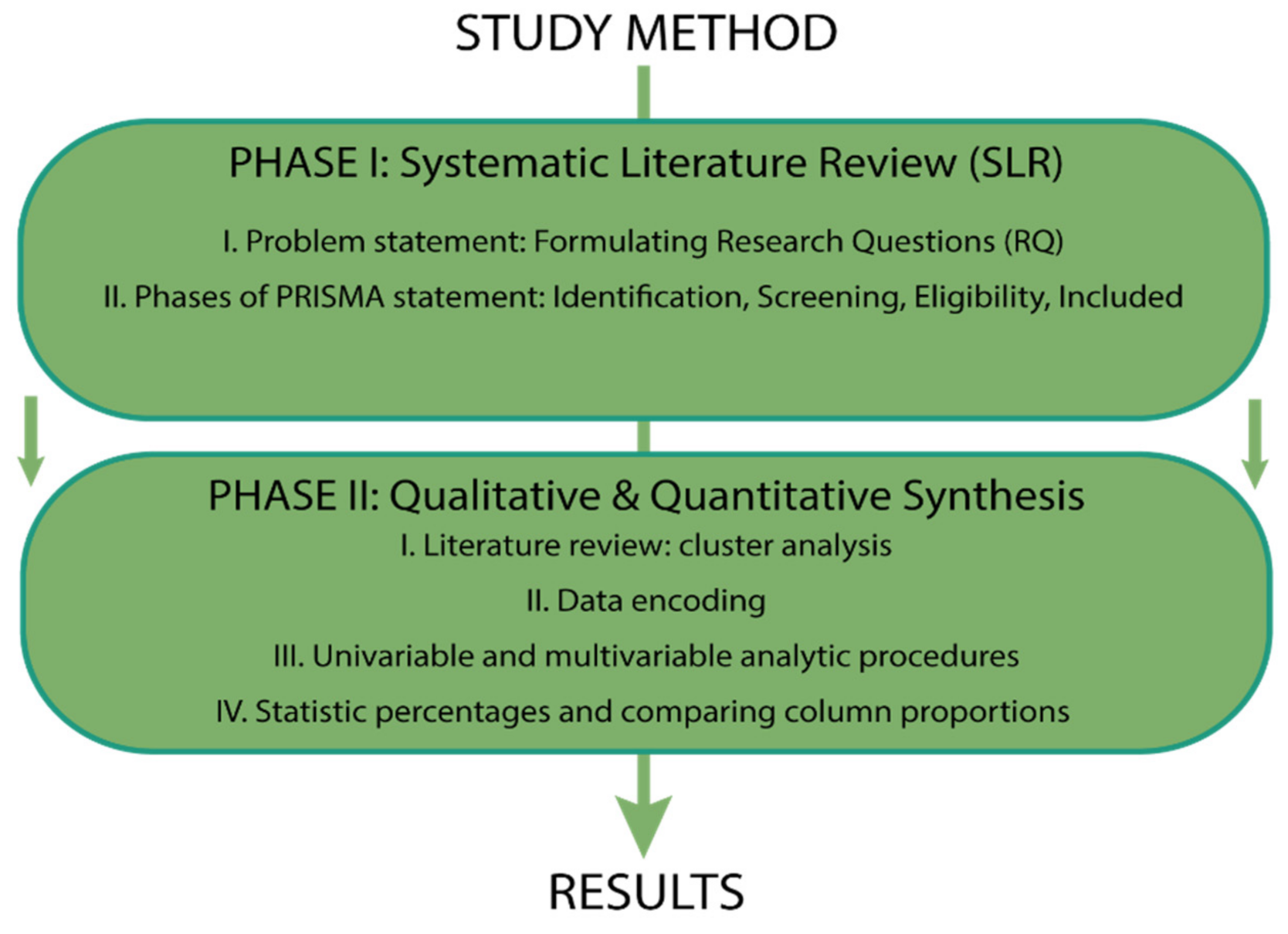
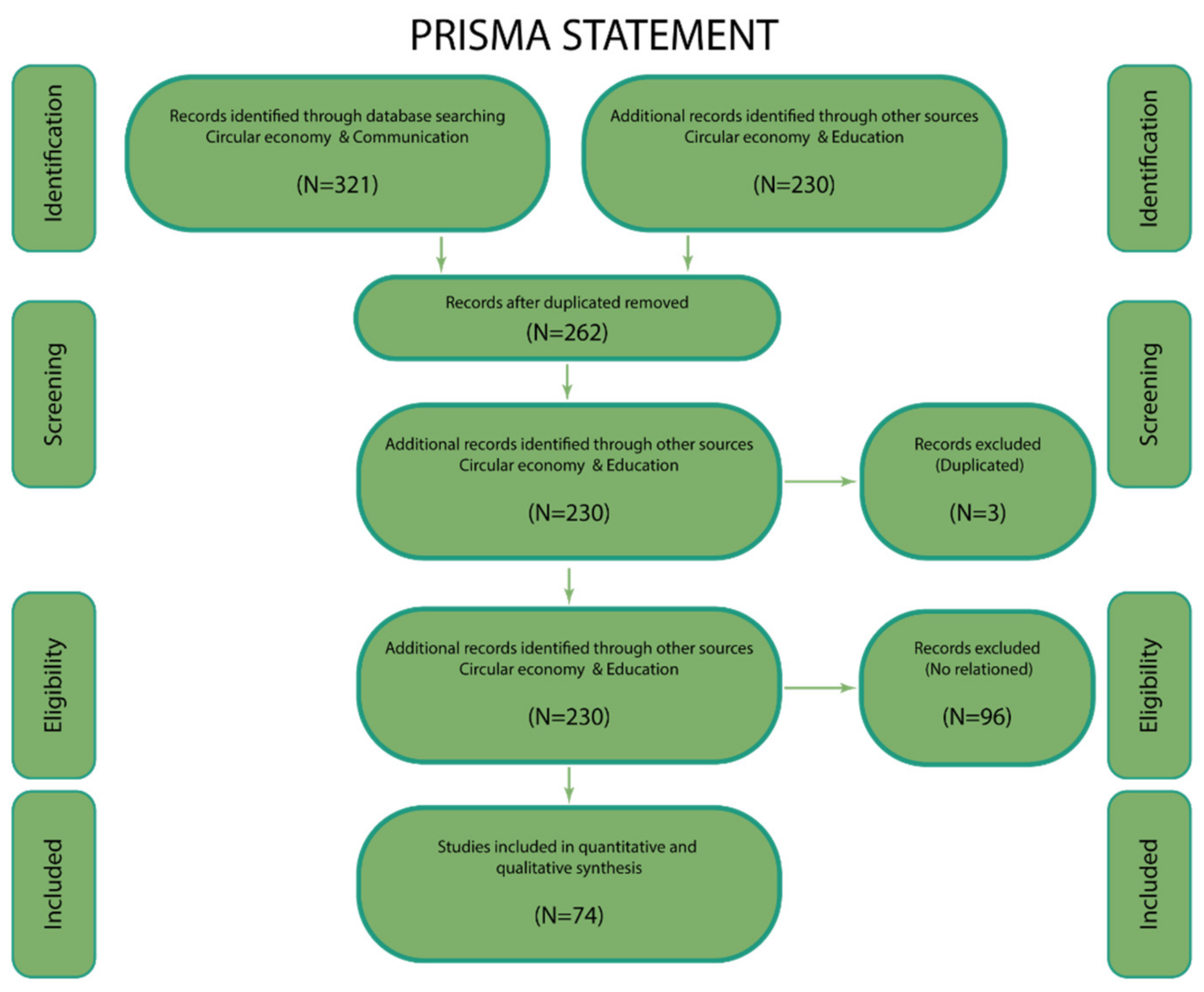
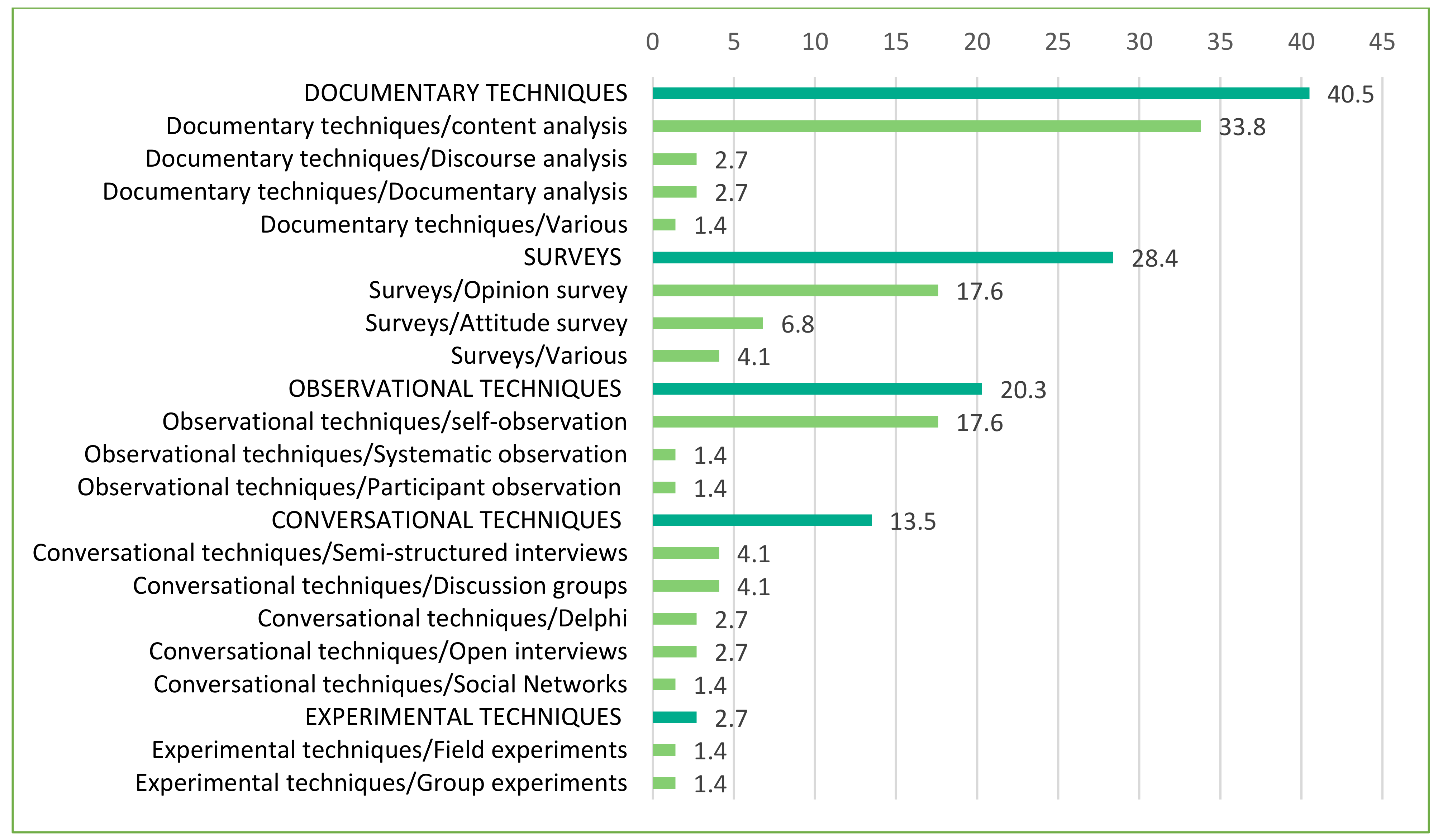
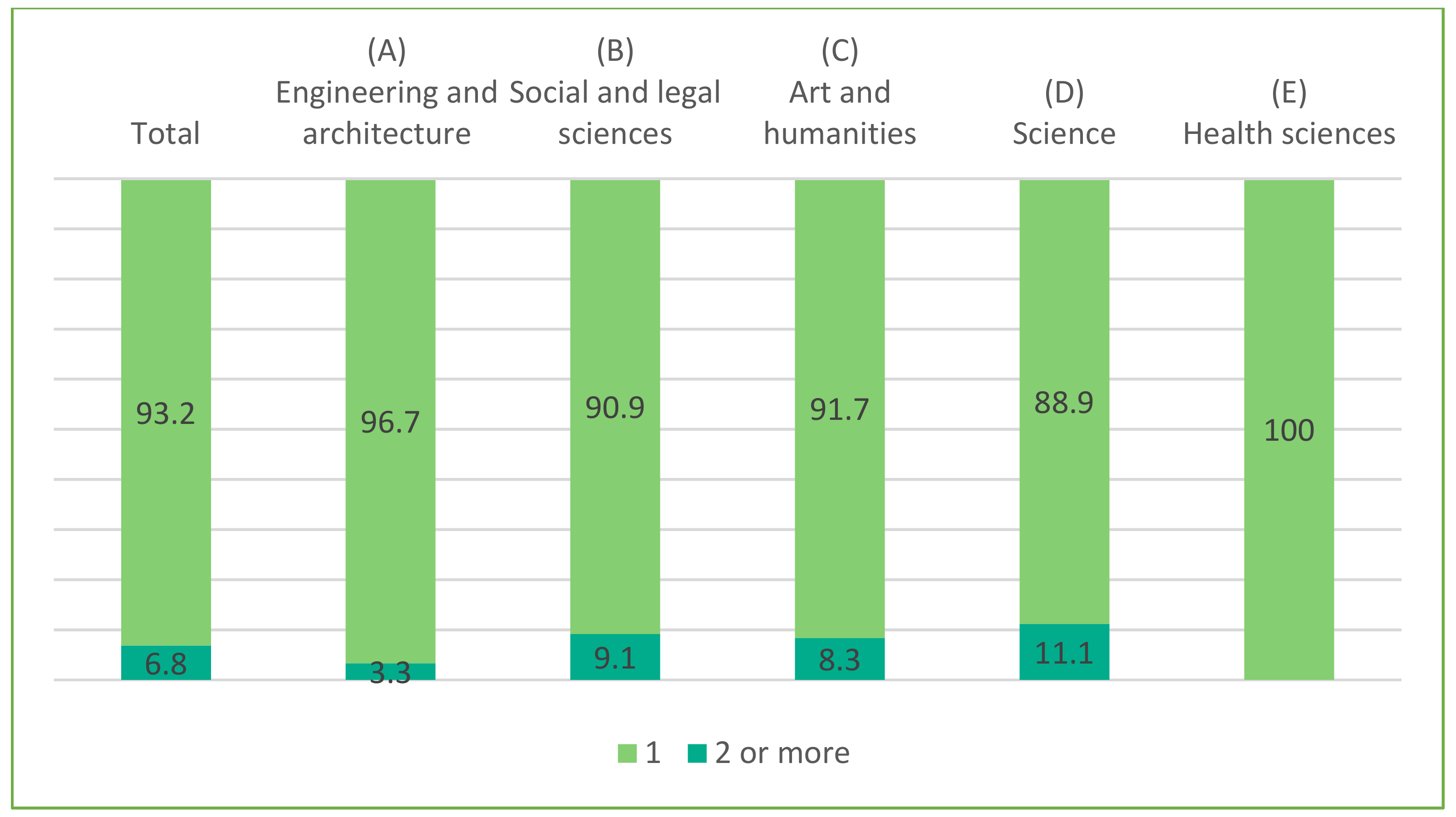
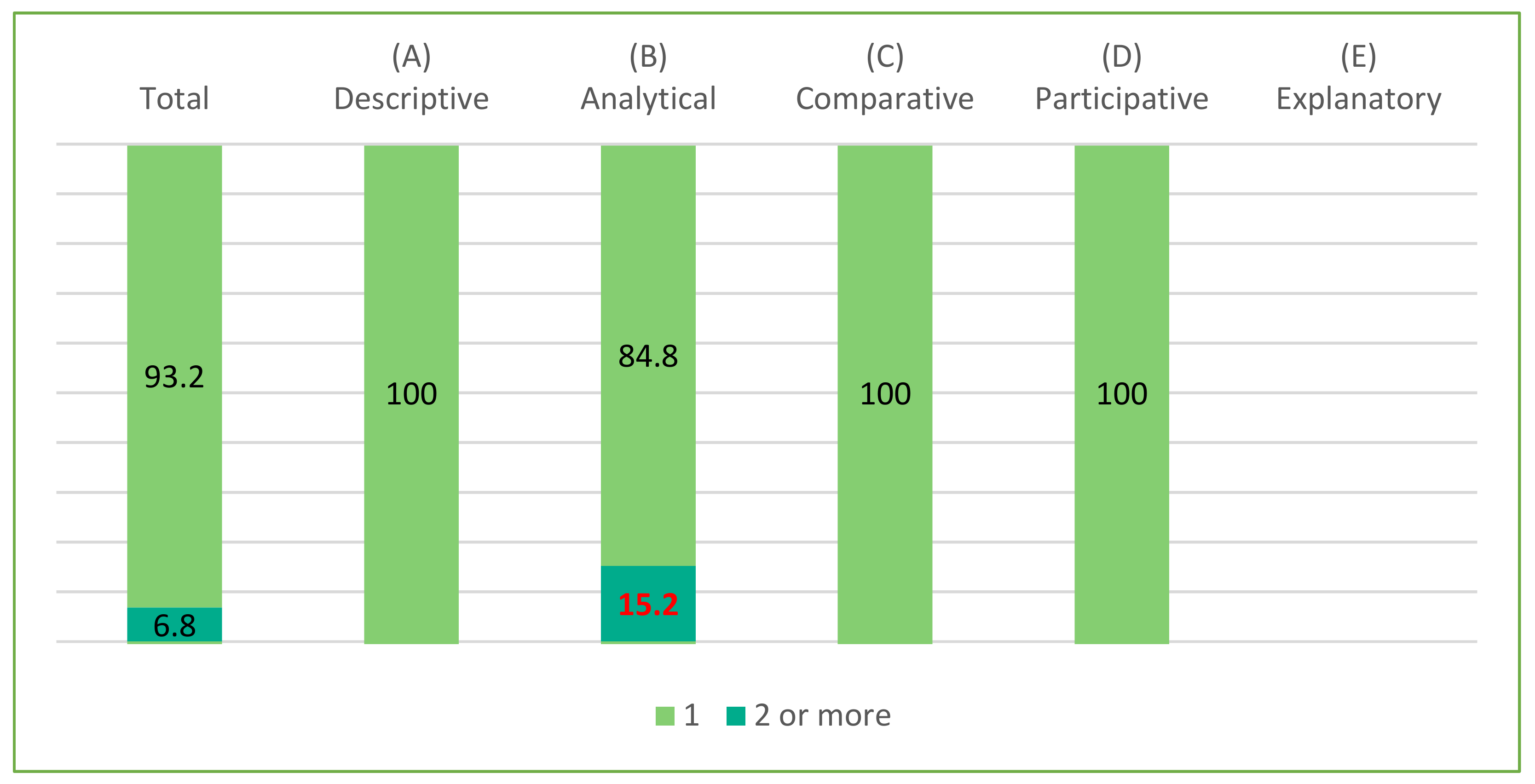

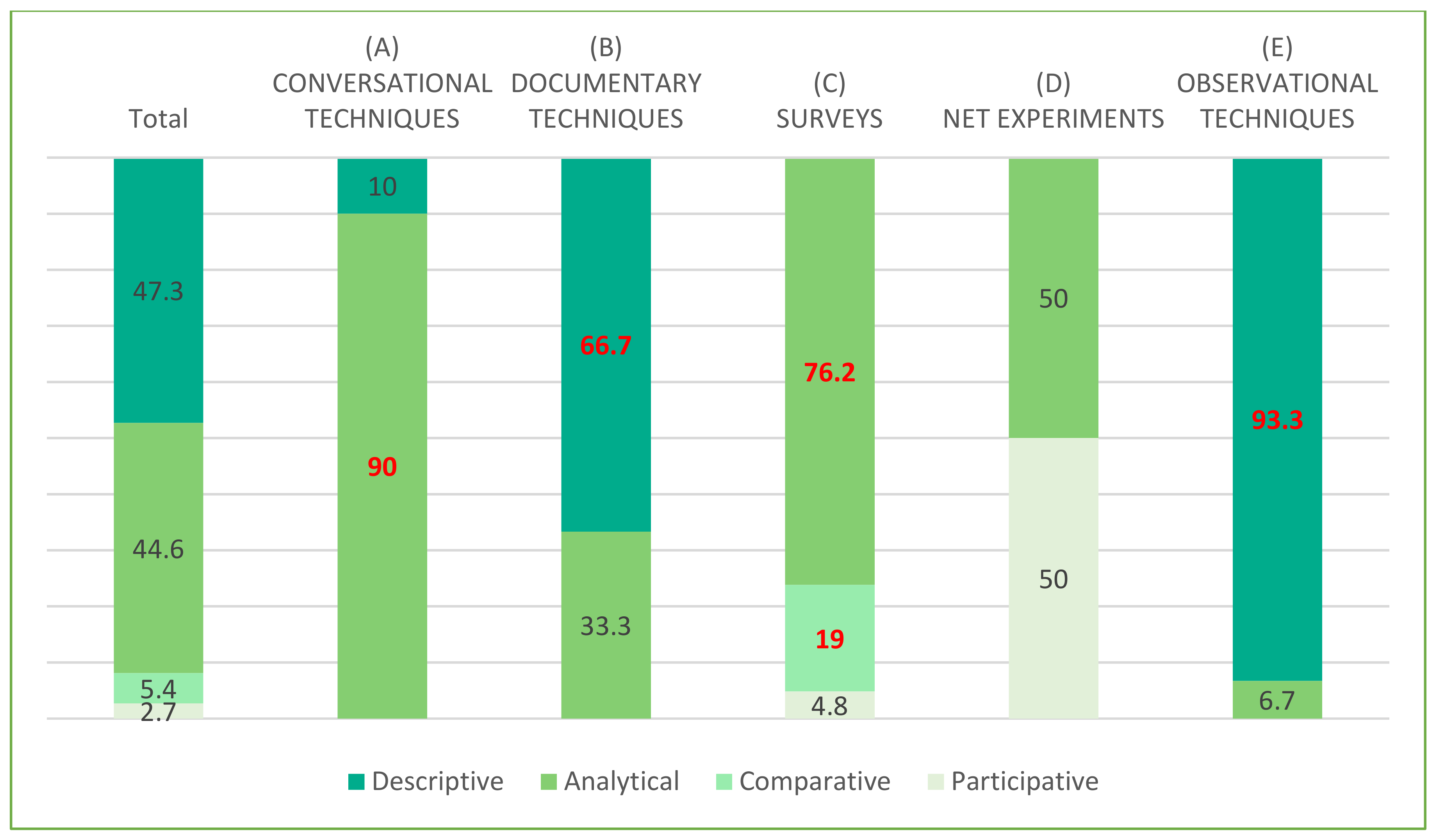
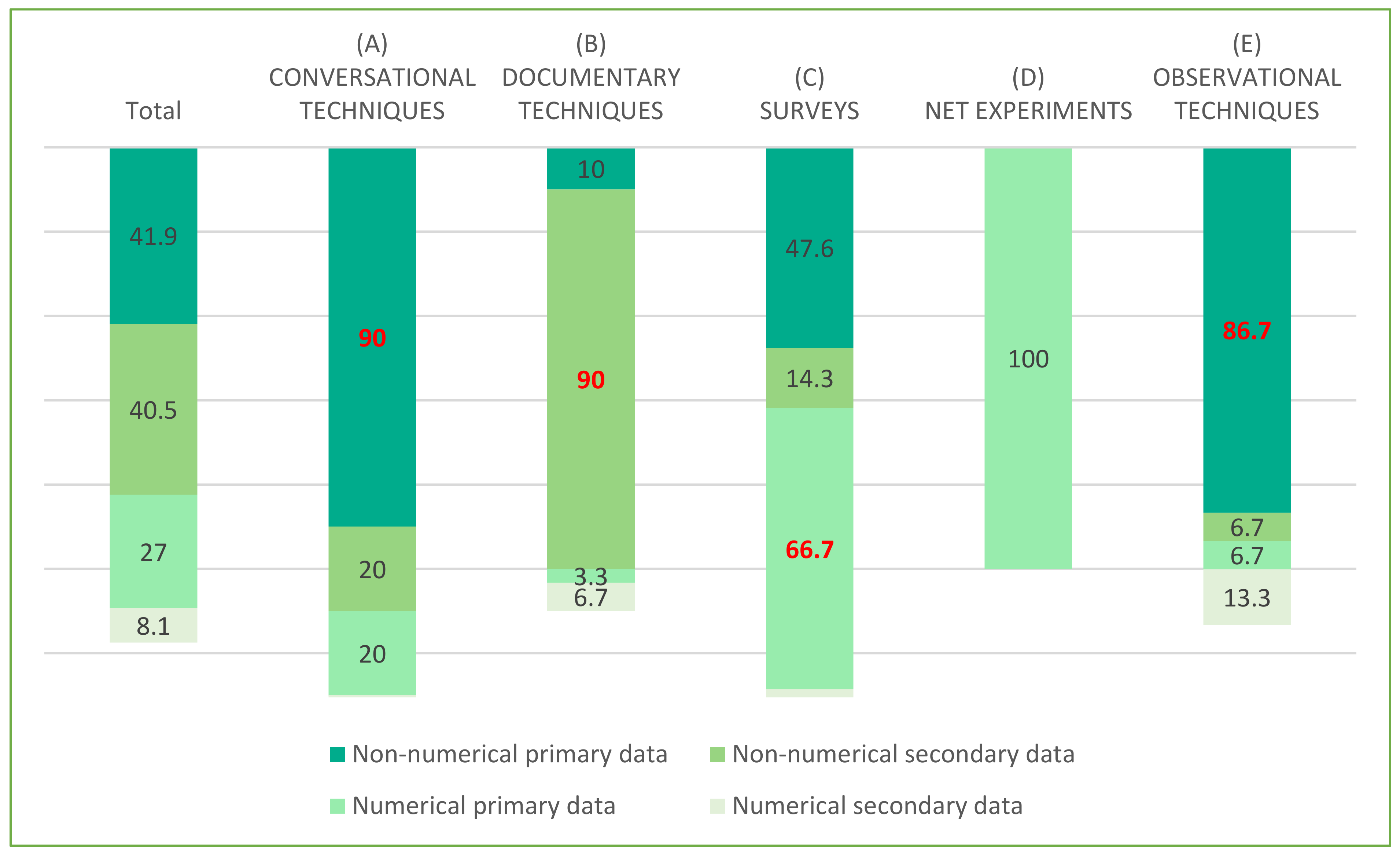
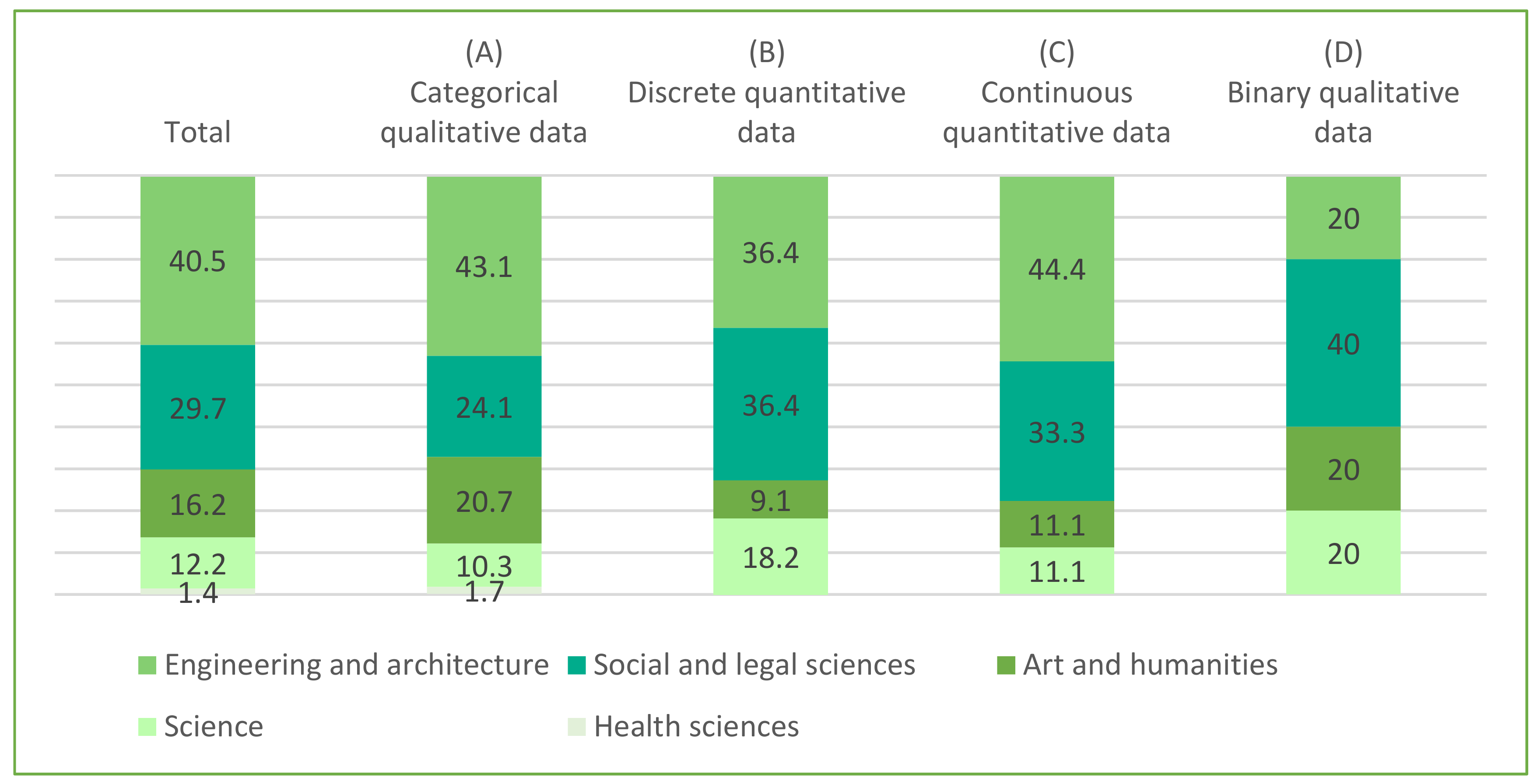
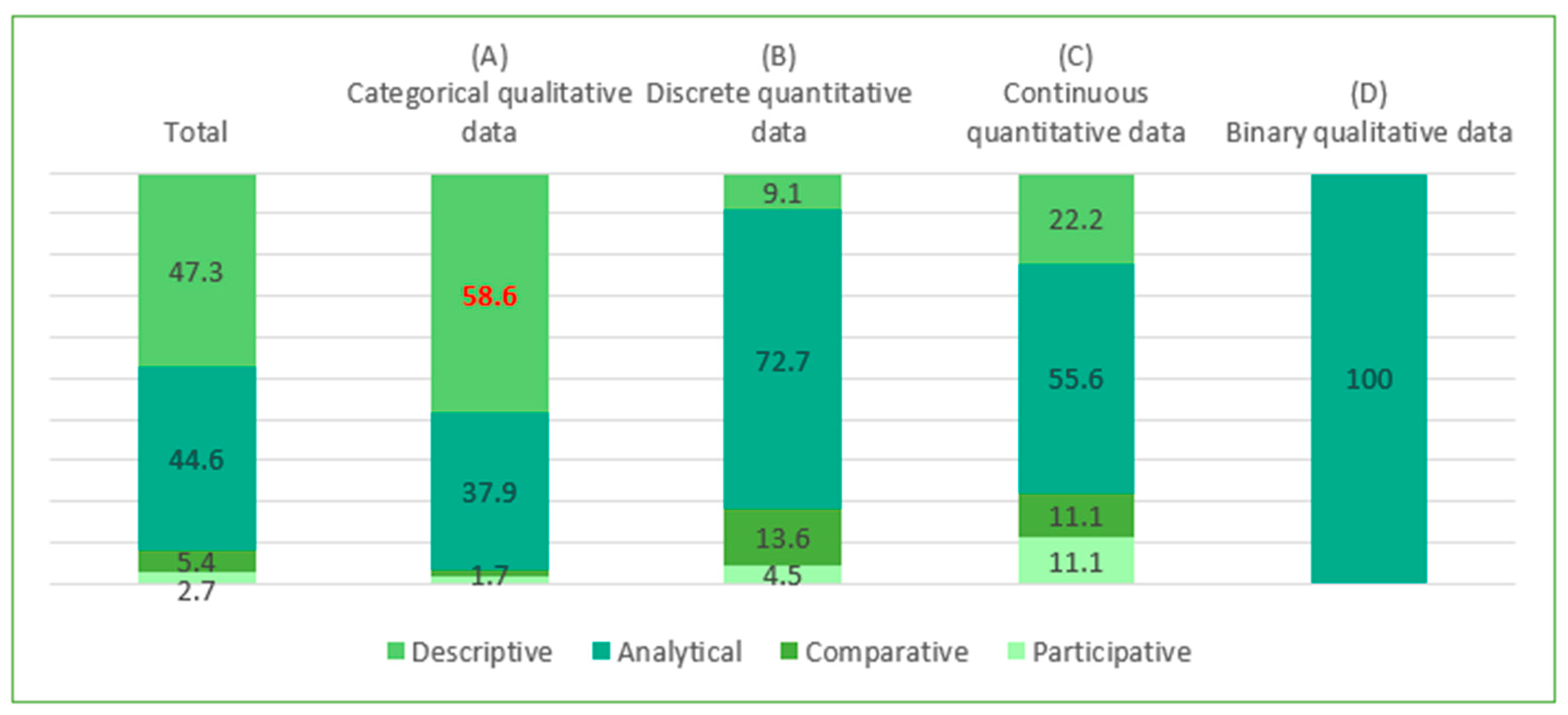
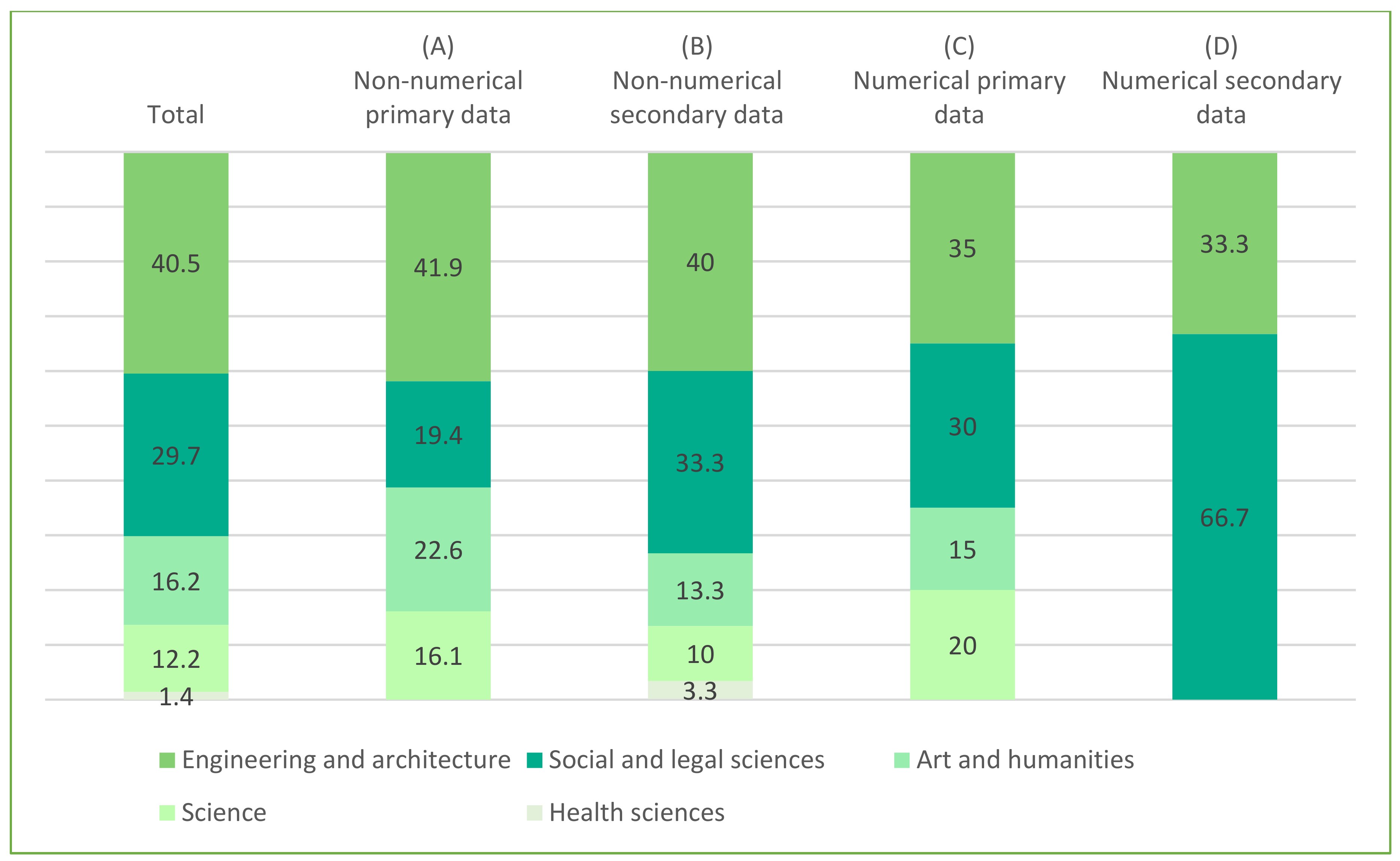
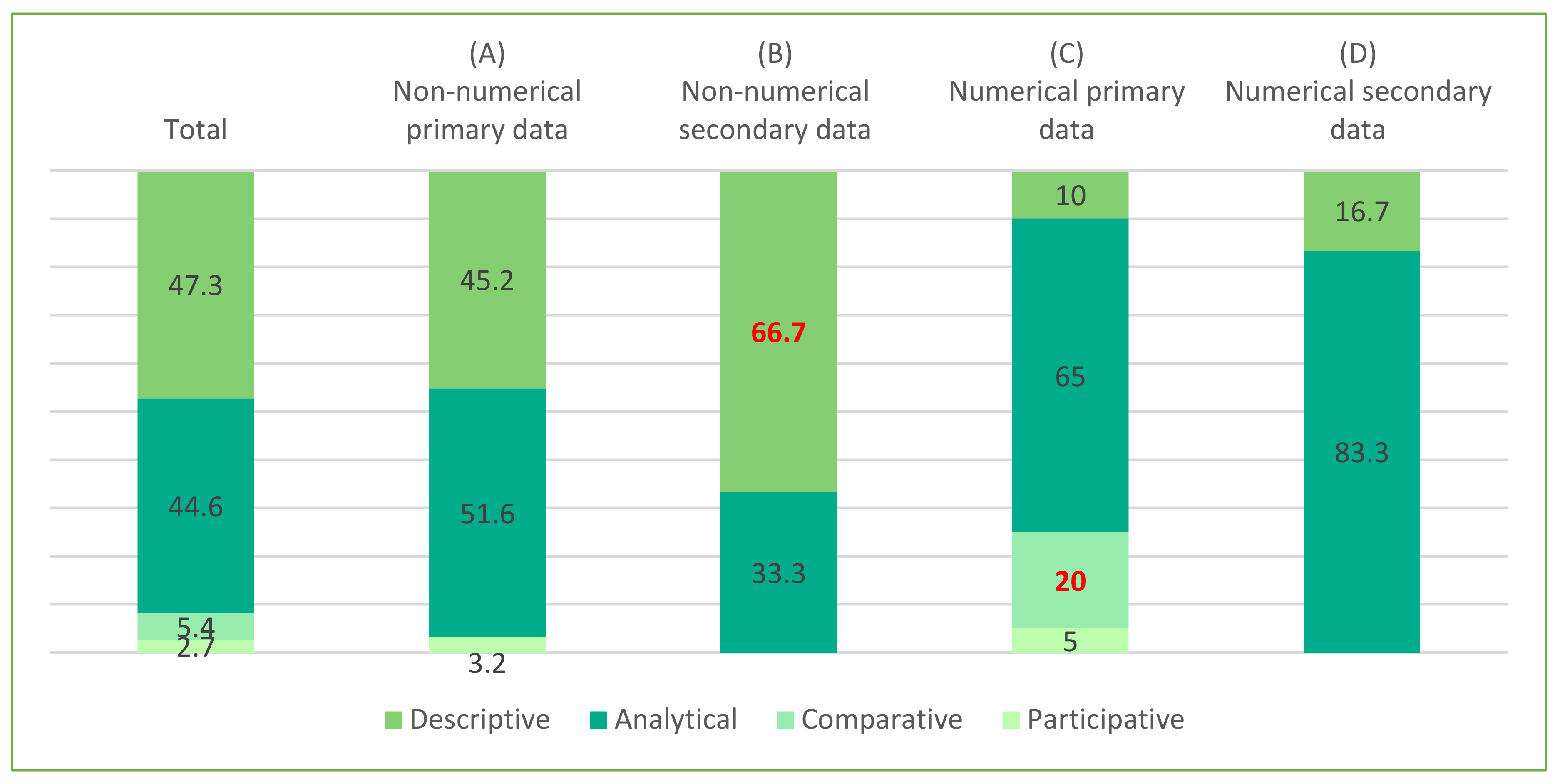
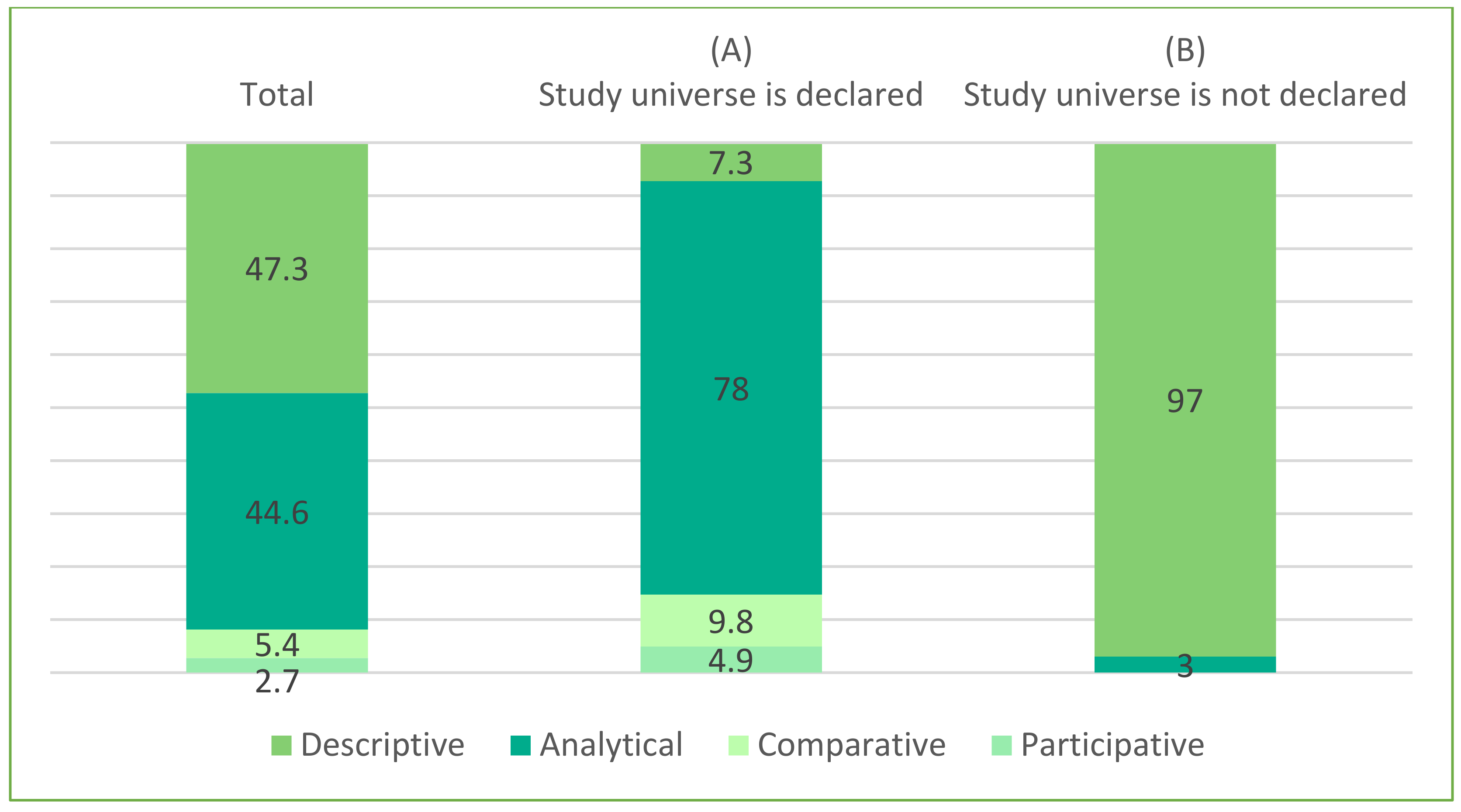
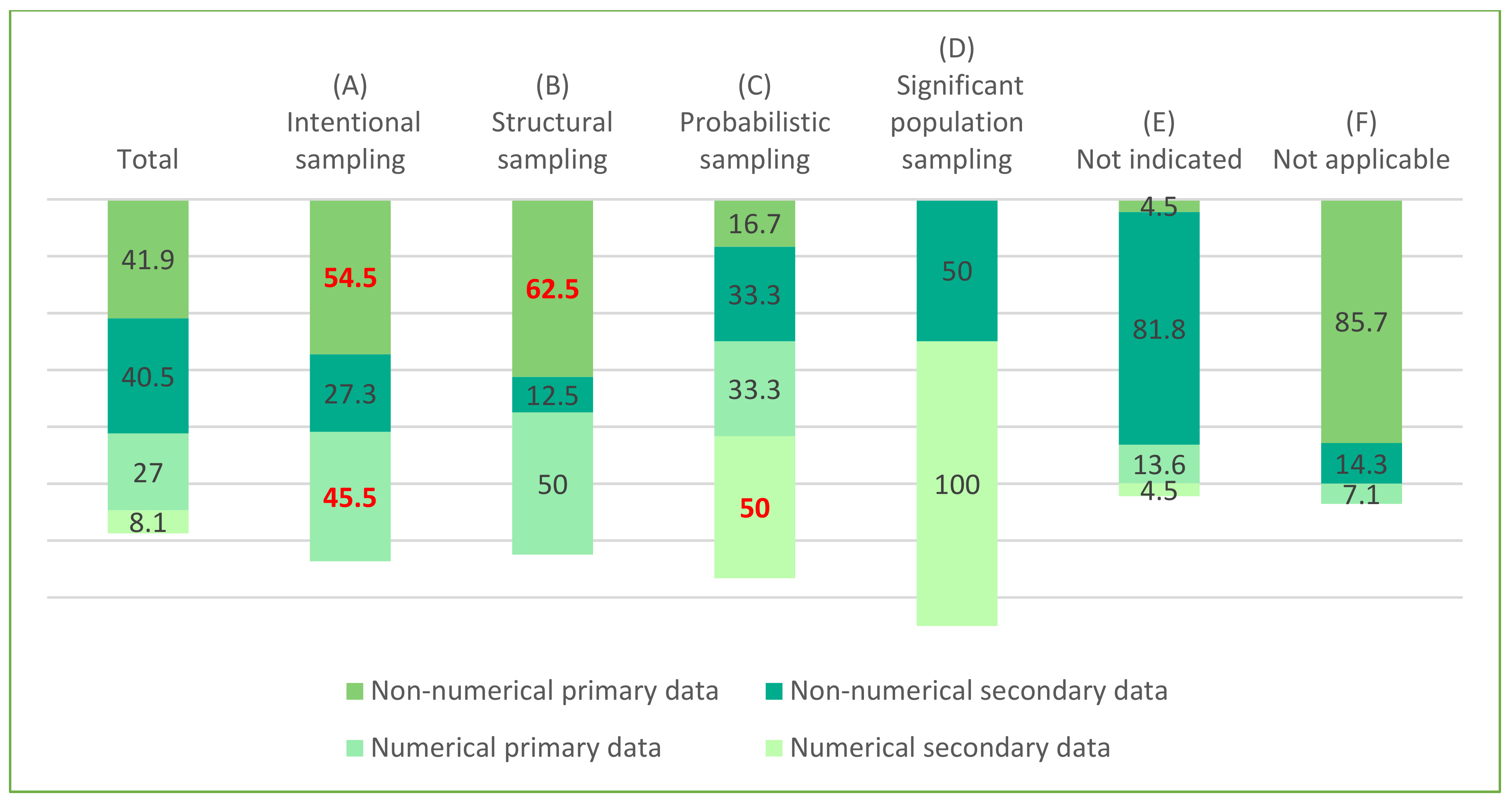
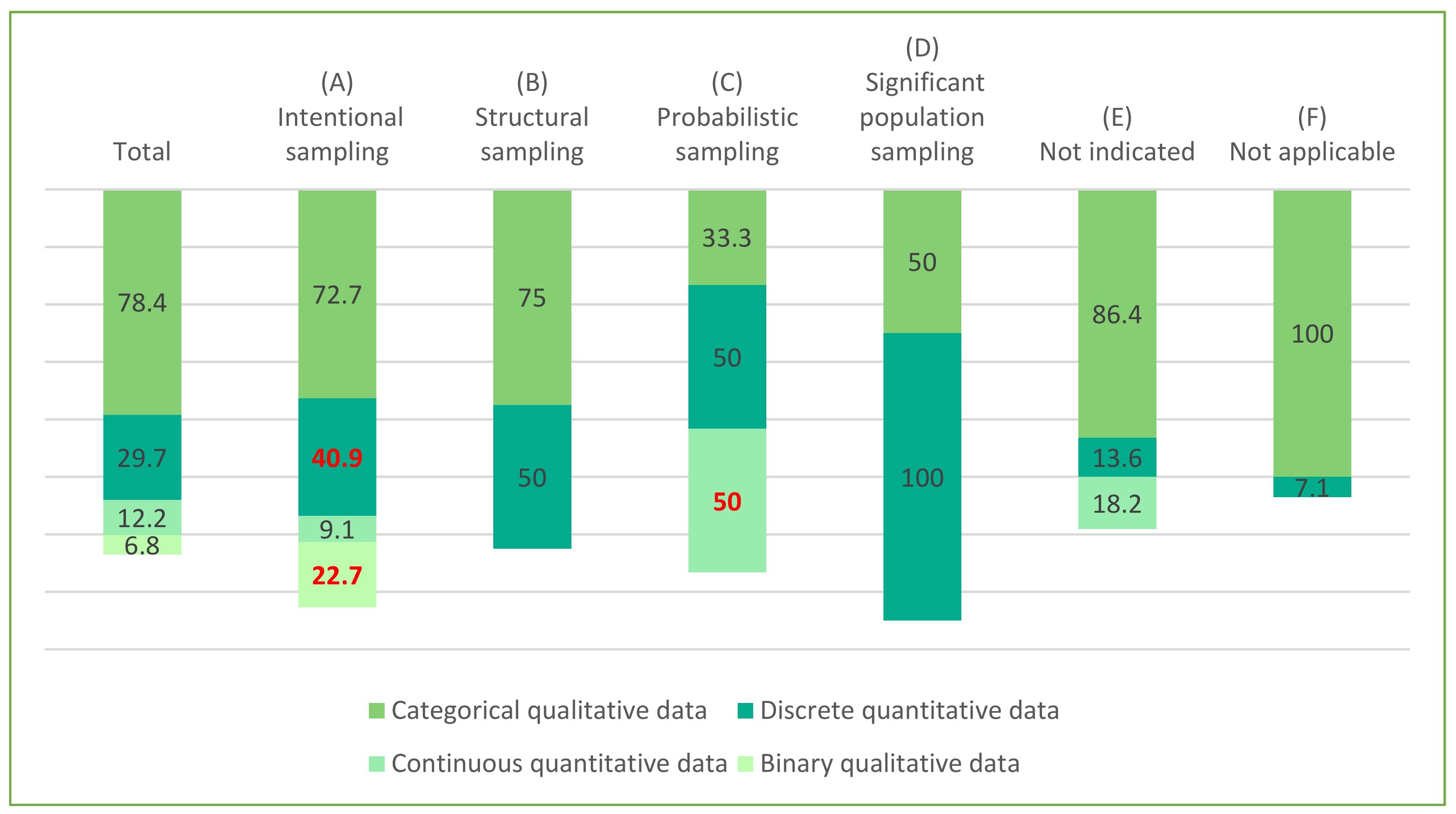
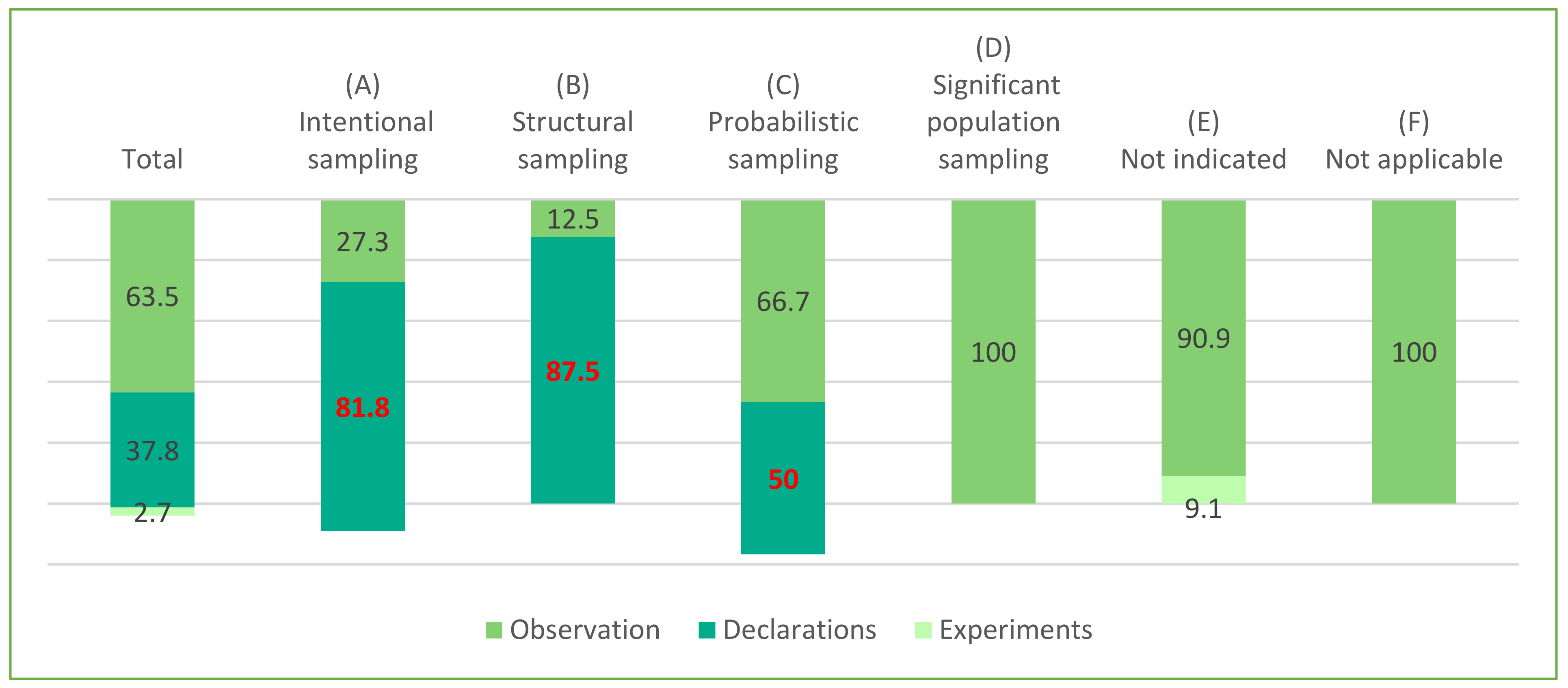
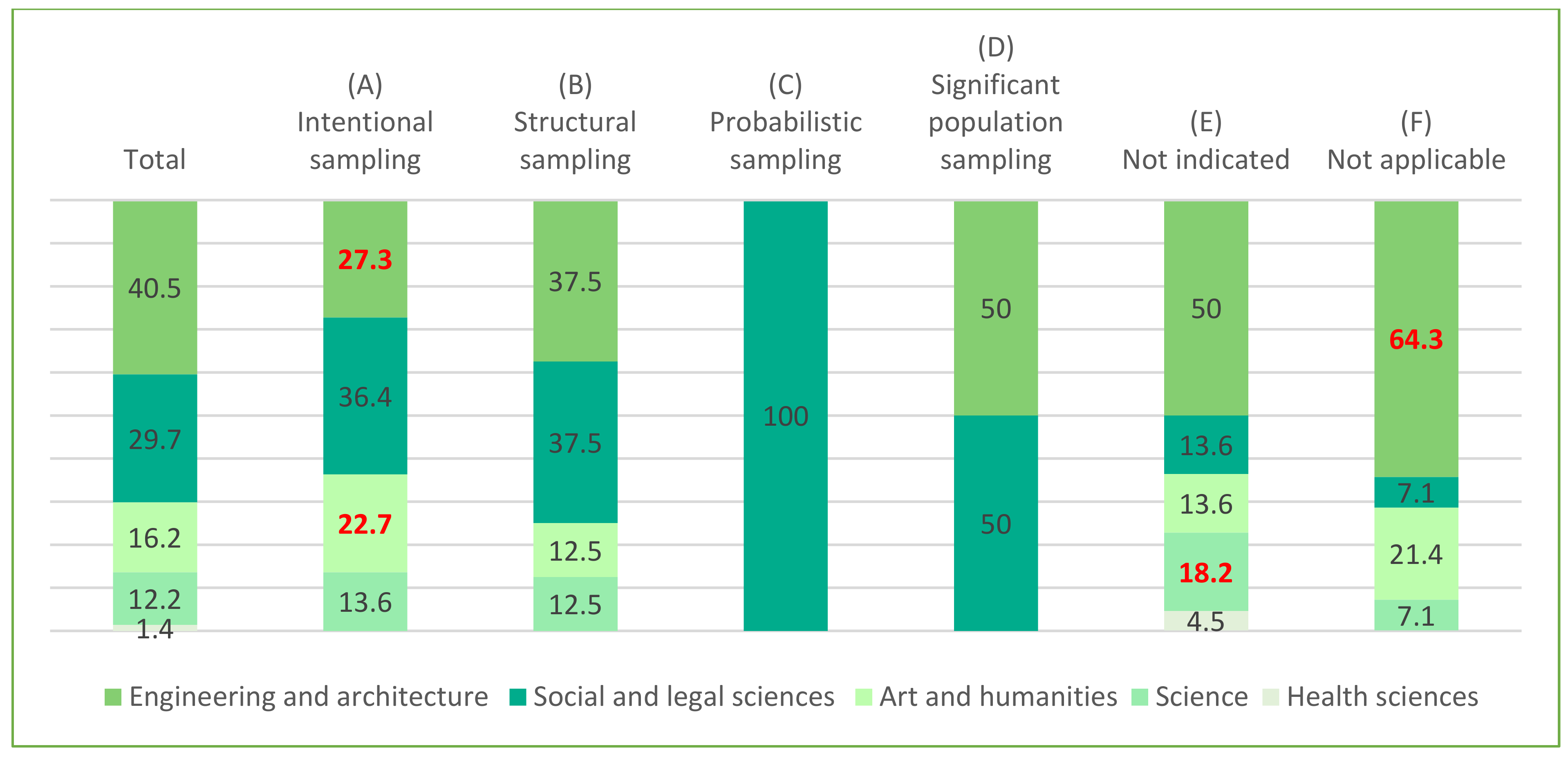
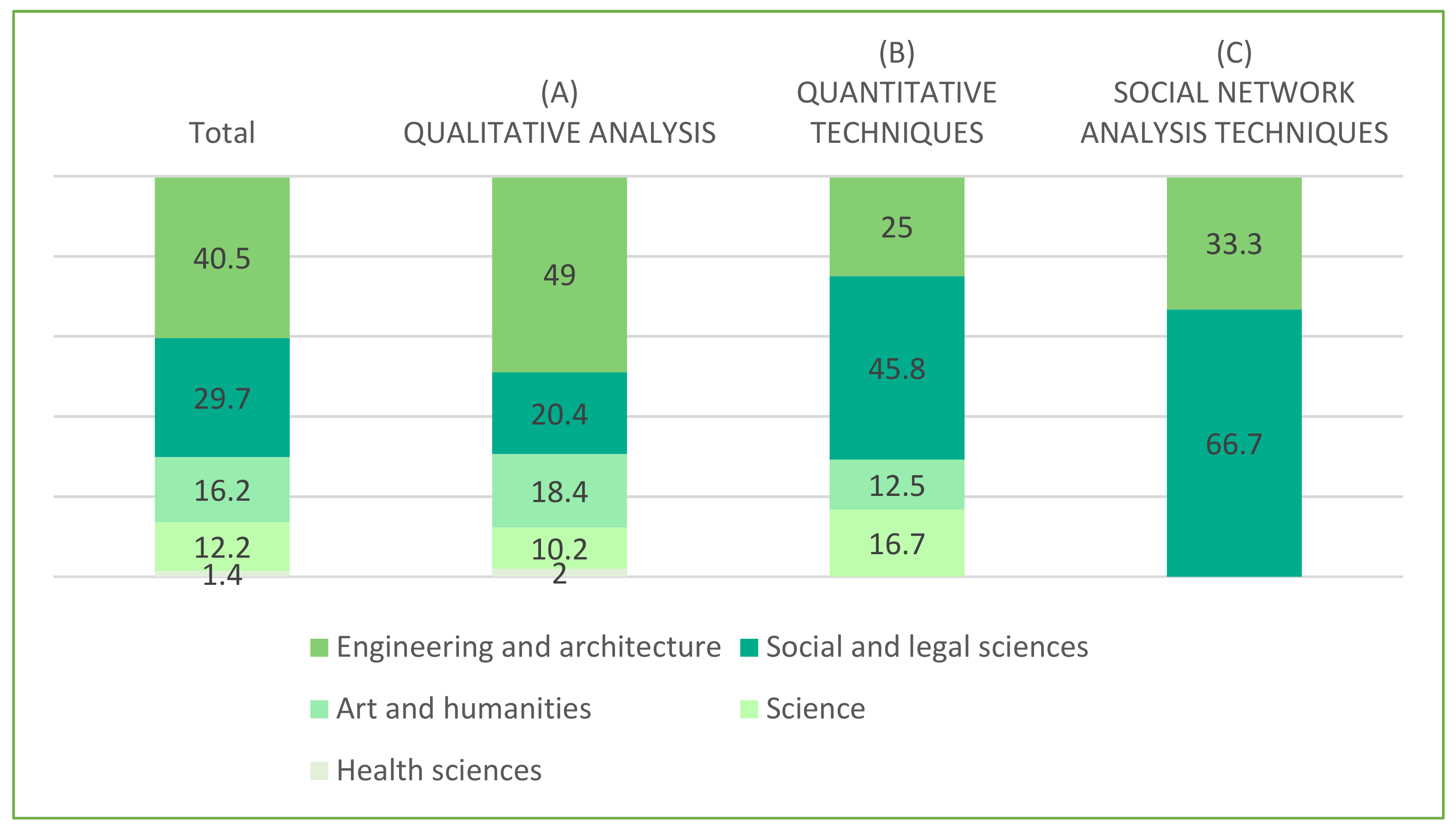
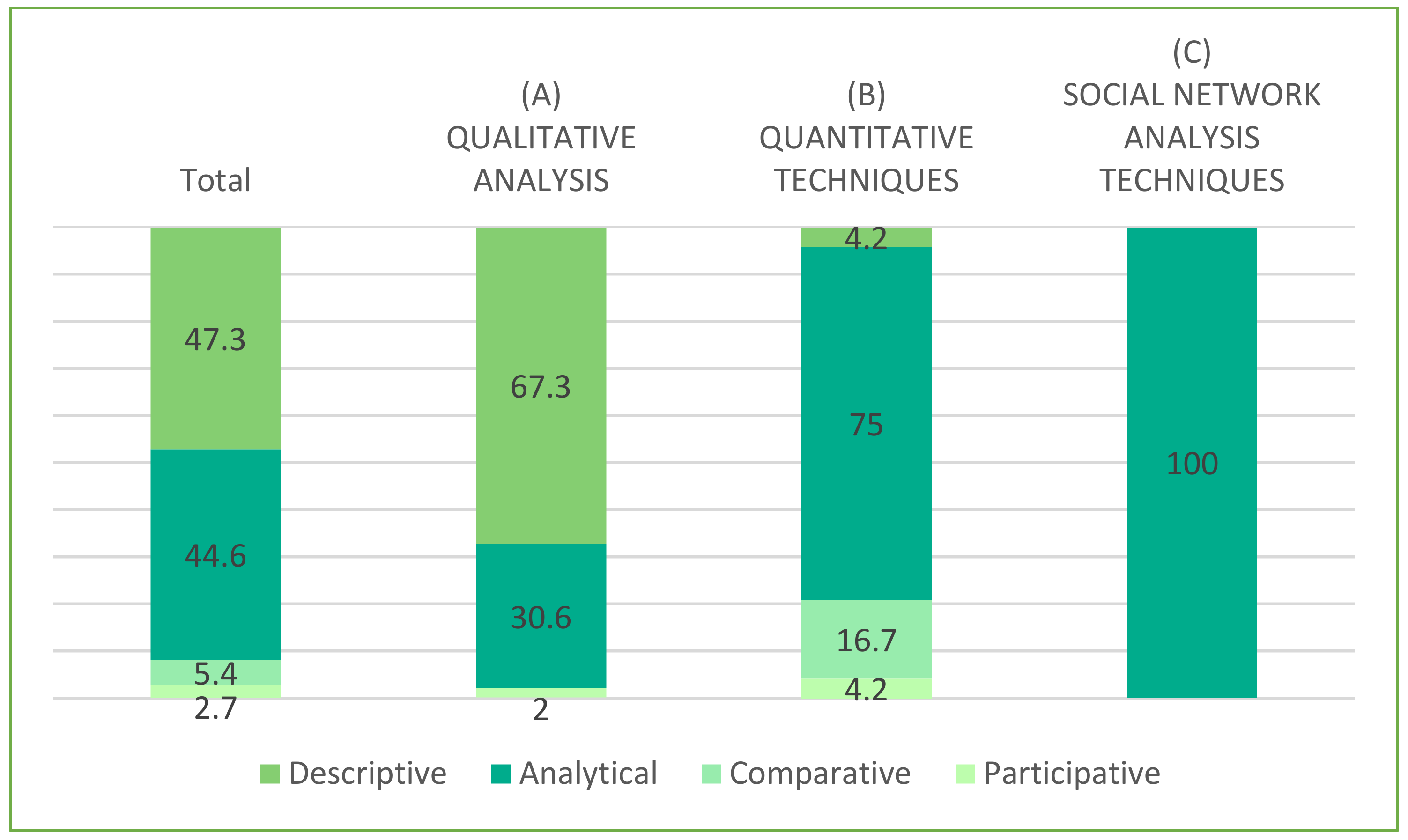
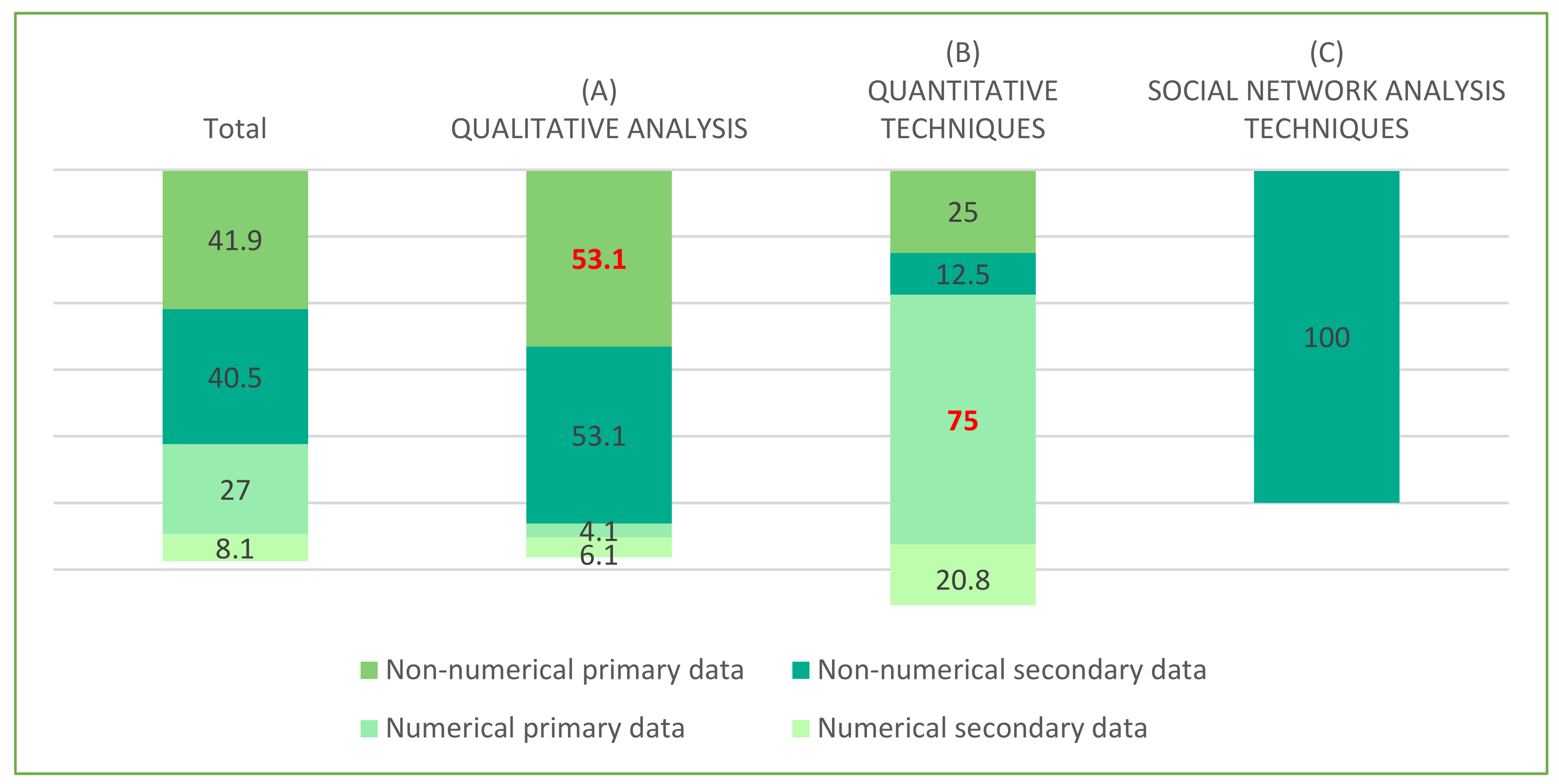
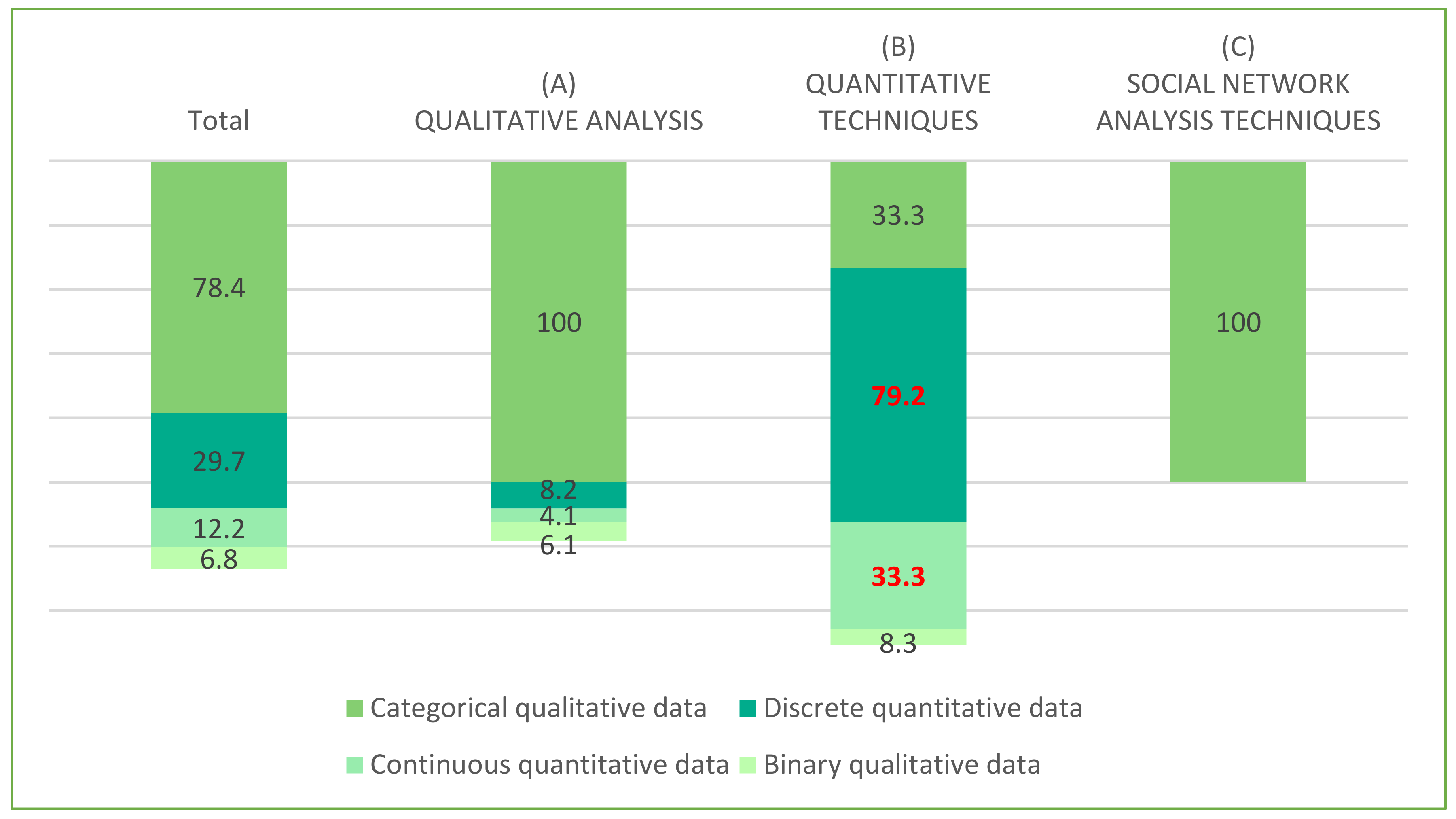
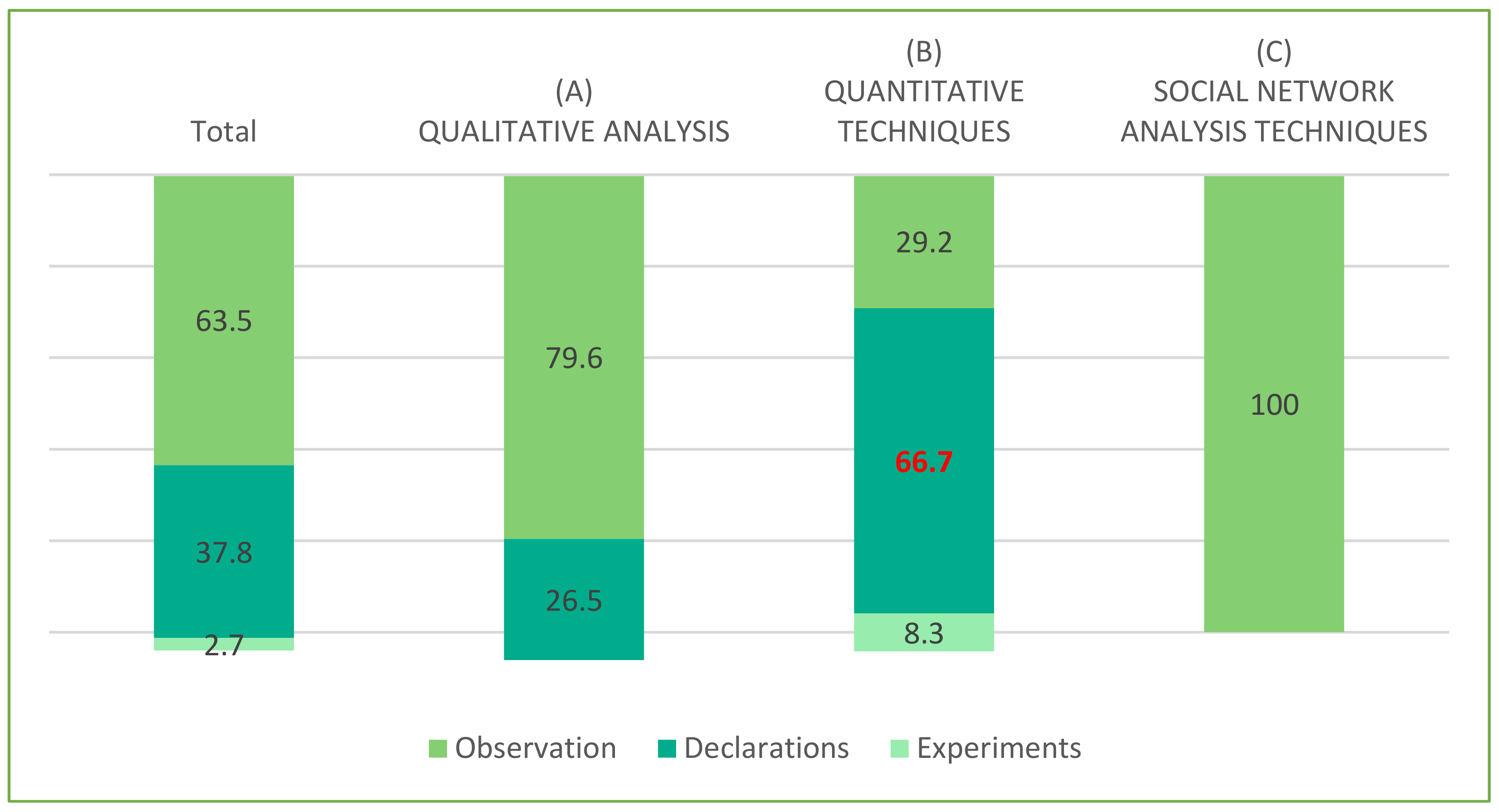
| Specific Objectives | Research Questions |
|---|---|
| SO1 | RQ1.1. Is there a dominant information collection technique? |
| RQ1.2. Does the information collection type determine one or another sample size? | |
| RQ1.3. In what disciplines is more than one information collection technique used? | |
| RQ1.4. In what type of research are more research techniques used? | |
| RQ1.5. Is there a relationship between collection techniques and the research discipline, type and objectives? | |
| RQ1.6. Is there a relationship between the type of information collection technique and the source of data obtained? | |
| SO2 | RQ2.1. What is the predominant source, nature and type of data collection? |
| RQ2.2. Is there a relationship between the nature of data and the research type and objective? | |
| RQ2.3. Is there a relationship between the source of data and the research discipline, type and objective? | |
| SO3 | RQ3.1. What type of research declares the study universe? |
| RQ3.2. What is the predominant sampling technique? | |
| RQ3.3. Is there a relationship between the sampling techniques and the source of data, nature, and data collection of the study? | |
| RQ3.4. Is there any relationship between the area of study and the sampling techniques? | |
| RQ3.5. Have the largest samples under the sampling techniques been selected? | |
| SO4 | RQ4.1. What are the predominant analysis techniques? |
| RQ4.2. Is there an association between analysis technique (primary and secondary) and research discipline, type and objectives? | |
| RQ4.3. Is there consistency between the type of analysis techniques used and the source of data, nature and collection of data? |
| General Vocabulary | Specific Words: Communication | ||||
|---|---|---|---|---|---|
| Urban biowaste | Advertising | Marketing | Persuasion | UX | Usability |
| Circular economy | Communication | Effectiveness | Memory | User experience | Digital content |
| Chemical biobased products | Communications | Engagement | Credibility | Experience | Cross media |
| Bioenergy | Media | Education | Attention | Eye-tracking | Transmedia |
| - | Digital | Higher education | Motivation | Eye tracking | 360° video |
| General Vocabulary | Specific Words: Education | |||
|---|---|---|---|---|
| Urban biowaste | Children | Distance-learning | Learning | Social Network |
| Circular economy | Education | E-learning | Research | Student |
| Chemical biobased products | Communication | Information technology | School | College students |
| Bioenergy | Media Literacy | Information Communication technology | Media | Communication education |
| - | Disinformation | Internet | Social Media | Learning experiment |
| Database | CE and Communication Publications | CE and Education Publications Added | Totals |
|---|---|---|---|
| Web of Science | 61 | 48 | 109 |
| Scopus | 96 | 83 | 179 |
| Google Scholar | 164 | 99 | 263 |
| Totals | 321 | 230 | 551 |
Publisher’s Note: MDPI stays neutral with regard to jurisdictional claims in published maps and institutional affiliations. |
© 2021 by the authors. Licensee MDPI, Basel, Switzerland. This article is an open access article distributed under the terms and conditions of the Creative Commons Attribution (CC BY) license (https://creativecommons.org/licenses/by/4.0/).
Share and Cite
Carbonell-Alcocer, A.; Romero-Luis, J.; Gertrudix, M. A Methodological Assessment Based on a Systematic Review of Circular Economy and Bioenergy Addressed by Education and Communication. Sustainability 2021, 13, 4273. https://doi.org/10.3390/su13084273
Carbonell-Alcocer A, Romero-Luis J, Gertrudix M. A Methodological Assessment Based on a Systematic Review of Circular Economy and Bioenergy Addressed by Education and Communication. Sustainability. 2021; 13(8):4273. https://doi.org/10.3390/su13084273
Chicago/Turabian StyleCarbonell-Alcocer, Alejandro, Juan Romero-Luis, and Manuel Gertrudix. 2021. "A Methodological Assessment Based on a Systematic Review of Circular Economy and Bioenergy Addressed by Education and Communication" Sustainability 13, no. 8: 4273. https://doi.org/10.3390/su13084273
APA StyleCarbonell-Alcocer, A., Romero-Luis, J., & Gertrudix, M. (2021). A Methodological Assessment Based on a Systematic Review of Circular Economy and Bioenergy Addressed by Education and Communication. Sustainability, 13(8), 4273. https://doi.org/10.3390/su13084273








